#because Constantinople is built on the Bosphorus
Explore tagged Tumblr posts
Text
Saints&Reading: Saturday, January 13, 2024
Leavetaking (apodosis) of the Nativity of Christ
december 31_ january 13
MARTYR ZOTICUS OF CONSTANTINOPLE, FEEDER OF ORPHANS (4TH C.)
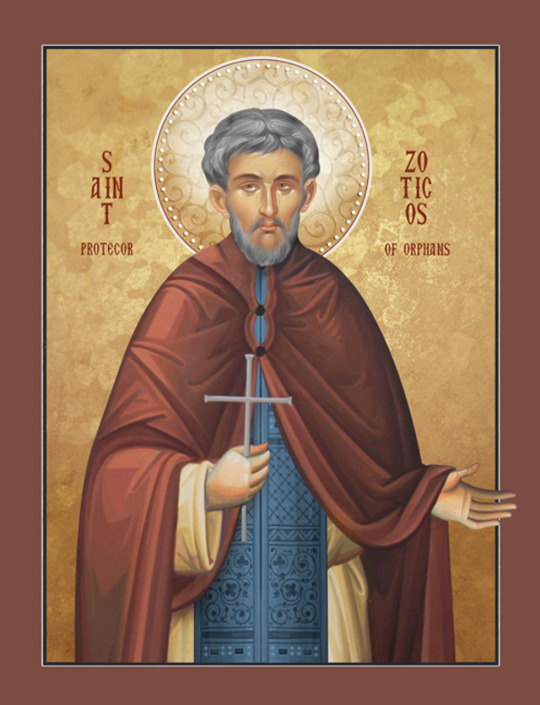
Icon from Uncut mountain suppy
He was born in Rome, and as a young man was chosen by the Emperor Constantine to assist in the foundation of his new capital at Byzantium. An outbreak of leprosy in the new City became so severe that the Emperor ordered that all lepers, whatever their rank, be driven from the city or drowned in the sea. Zoticus, moved by compassion for these people, went to the Emperor and asked him for a large amount of gold to buy gems and pearls to enhance the glory of the city, 'For, as Your Majesty knows, I am well-qualified in this field.' The Saint then used the gold to ransom all those being led into exile or to drowning, and to establish for them a camp on the hill of Olivet on the opposite shore of the Bosphorus. There he brought the sick and provided for their care. In 337 Constantius, an Arian heretic, took the throne upon the death of his father. Some of Zoticus' enemies at court, seeing an opportunity, denounced Zoticus to the new Emperor, saying that he not only held subversive views, but had misappropriated public money. When he learned of these charges, Zoticus presented himself to the Emperor, finely dressed, and offered to take Constantius to see the gems and pearls that he had bought on his behalf. When they reached the hill of Olivet, Constantius was astonished to see a company of lepers coming to greet him with lighted candles, honoring and praising him and their patron Zoticus. Then the holy Zoticus said to the Emperor, 'These are the precious stones and brilliant pearls that give luster to the crown of the heavenly Kingdom that you will inherit by their prayers. I bought them for the salvation of your soul.'Instead of being grateful, the heartless Emperor ordered that Zoticus be tied behind wild mules and dragged until dead. The mules ran down the hill, breaking the Saint's body upon the rocks an brush. Then, of their own accord, they returned to the top of the hill, still dragging the body, and, like Balaam's ass (Numbers ch. 22), spoke and proclaimed that the Martyr must be buried on that hill. The astonished and repentant Emperor ordered the Martyr buried with honor, and commanded that a hospital for lepers be built there, staffed by the best physicians and caretakers. Saint Zoticus is also called Orphanotrophos, 'Cherisher of Orphans,' because in later years a large orphanage was added to the leprosarium. The orphanage included a general hospital and a home for the aged. The Saint was honored throughout Byzantine history as the patron of the orphanage.
VENERABLE MELANIA THE YOUNGER, NUN OF ROME(439)
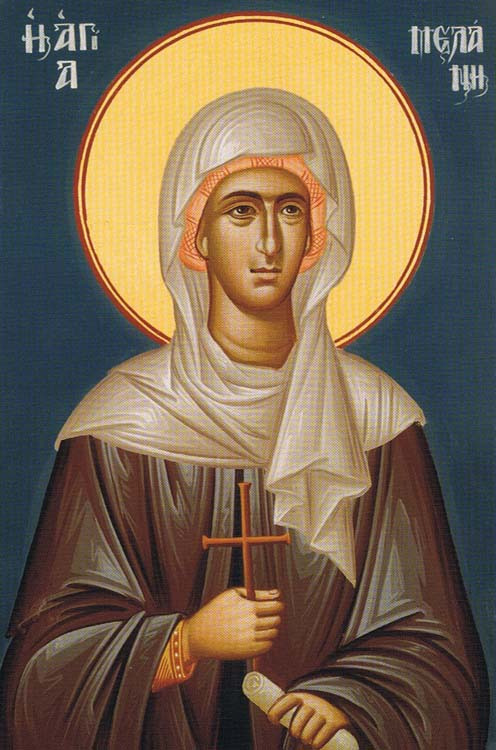
Saint Melania was born in Rome into a devout Christian family. Her parents, people of property and wealth, hoped that their daughter would marry and have children who would inherit their wealth.
At fourteen years of age Melania was married to the illustrious youth Apinianus. From the very beginning of their married life, Saint Melania asked her husband to live with her in chastity or else release her from the marriage. Apinianus answered, “I cannot agree to this right now. When we have two children to inherit the property, then we shall both renounce the world.”
Soon Melania gave birth to a daughter, whom the young parents dedicated to God. Continuing to live together in marriage, Melania secretly wore a hair shirt and spent her nights in prayer. The second child, a boy, was premature and had severe complications. They baptized him, and he departed to the Lord.
Seeing the suffering of his wife, Apinianus asked the Lord to preserve Saint Melania’s life, and he vowed to spend the rest of their life together in chastity. Recovering, Saint Melania stopped wearing her beautiful clothing and jewelry. Soon their daughter also died. The parents of Saint Melania did not support the young couple’s desire to devote themselves to God. It was only when Saint Melania’s father became deathly ill, that he asked their forgiveness and permitted them to follow their chosen path, asking them to pray for him.
The saints then left the city of Rome, and began a new life completely dedicated to the service of God. Apinianus at this time was twenty-four years of age, and Melania twenty. They began to visit the sick, to take in wanderers, and to help the indigent. They visited those who were exiled, and mine-convicts, and the destitute, there in debtor’s prison. After selling their estates in Italy and Spain, they generously helped monasteries, hospitals, widows and orphans in Mesopotamia, Syria, Egypt, Phoenicia, and Palestine.
Many churches and hospitals were built with their assistance. Churches of both West and East benefited from them. Leaving their native land, they set sail for Africa, and a strong storm arose while they were at sea. The sailors said that this was because of the wrath of God, but Saint Melania said that it was not God’s will that they should go directly to their destination.
The waves carried the ship to an island on which barbarians had landed. The besiegers demanded a ransom from the inhabitants, or else they threatened to lay waste the city. The saints supplied the necessary ransom, and thus saved the city and its people from destruction.
Resuming their voyage, they landed in Africa and helped all the needy there. With the blessing of the local bishops, they made offerings to churches and monasteries. During this time Saint Melania continued to humble her flesh by strict fasting, and she fortified her soul by constantly reading the Word of God, making copies of the sacred books and distributing them to those who lacked them. She sewed a hairshirt for herself, put it on, and continued to wear it.
The saints spent seven years in Carthage, and then decided to visit Jerusalem. At Alexandria, they were welcomed by the bishop, Saint Cyril, and they met in church with the holy Elder Nestorius, who was possessed of the gift of prophecy and healing. The Elder turned to them and told them to have courage and patience in expectation of the Glory of Heaven.
At Jerusalem, the saints distributed their remaining gold to the destitute and then spent their days in poverty and prayer. After a short visit to Egypt, where the saints visited many of the desert Fathers, Saint Melania secluded herself in a cell on the Mount of Olives. Only occasionally did she see Saint Apinianus.
Later, she founded a monastery, where eventually ninety virgins lived in obedience to Saint Melania. Out of humility, she would not consent to be abbess, and lived and prayed in solitude as before. In her instructions, Saint Melania urged the sisters to be vigilant and to pray, to disdain their own opinions and cultivate first of all love for God and for one another, to keep the holy Orthodox Faith, and to guard their purity of soul and of body.
In particular, she exhorted them to be obedient to the will of God. Calling to mind the words of the Apostle Paul, she counselled them to keep the fasts “not with wailing, nor from compulsion, but in virtuous disposition with love for God”. By her efforts an oratory and altar were built in the monastery, where they enshrined the relics of saints: the Prophet Zachariah, the holy Protomartyr Stephen, and the Forty Martyrs of Sebaste. About this time Saint Apinianus fell asleep in the Lord. Saint Melania buried his relics and there spent another four years in fasting and unceasing prayer.
Saint Melania wanted to build a men’s monastery on the Mount of the Ascension of the Lord. The Lord blessed her intent by sending a benefactor who provided the means for the monastery. Joyfully accepting it, Saint Melania finished the great work in a single year. In this monastery, saintly men began to lift up unceasing prayer in the church of the Ascension of Christ.
Having completed her tasks, the saint left Jerusalem for Constantinople, hoping to save the soul of her pagan uncle Volusianus who had traveled there from Rome. Along the way she prayed at the relics of Saint Laurence (August 10), at the place of his martyrdom, and received auspicious signs. Arriving in Constantinople, the saint found her uncle had fallen ill. Her demeanor and her inspired discourses had a profound influence on the sick man. He gave up pagan impiety and died a Christian.
During this time many inhabitants of the capital were deceived by the heretical teaching of Nestorius. Saint Melania accepted anyone who turned to her for proper explanation, converting many of them to Orthodoxy. Many miracles were worked through the prayers of the saint.
Returning to her own monastery, the saint sensed the approach of death, and told this to the priest and the sisters. They listened to her final instructions with deep sorrow and with tears. Having asked their prayers and commanding them to preserve themselves in purity, she received the Holy Mysteries with joy. Saint Melania peacefully gave up her soul to the Lord in the year 439.
Source: Orthodox Church in America_OCA
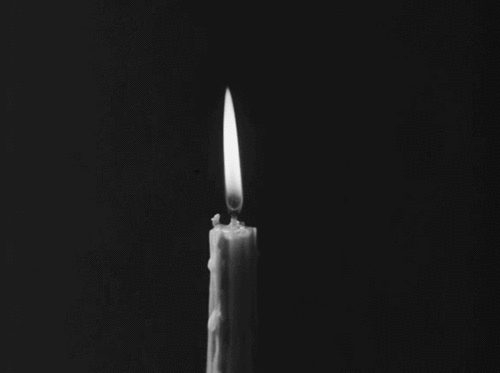
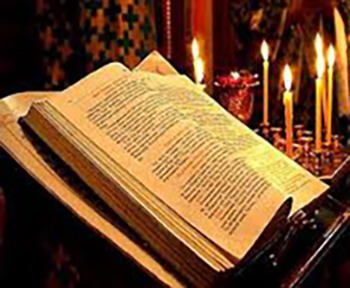
1 THESSALONIANS 5:14-23
14 Now we exhort you, brethren, warn those who are unruly, comfort the fainthearted, uphold the weak, be patient with all. 15 See that no one renders evil for evil to anyone, but always pursue what is good both for yourselves and for all. 16 Rejoice always, 17 pray without ceasing, 18 in everything give thanks; for this is the will of God in Christ Jesus for you. 19 Do not quench the Spirit. 20 Do not despise prophecies. 21 Test all things; hold fast what is good. 22 Abstain from every form of evil. 23 Now may the God of peace Himself sanctify you completely; and may your whole spirit, soul, and body be preserved blameless at the coming of our Lord Jesus Christ.
LUKE 17:3-10
3 Take heed to yourselves. If your brother sins against you, rebuke him; and if he repents, forgive him. 4 And if he sins against you seven times in a day, and seven times in a day returns to you, saying, 'I repent,' you shall forgive him. 5 And the apostles said to the Lord, "Increase our faith." 6 So the Lord said, "If you have faith as a mustard seed, you can say to this mulberry tree, 'Be pulled up by the roots and be planted in the sea,' and it would obey you. 7 And which of you, having a servant plowing or tending sheep, will say to him when he has come in from the field, 'Come at once and sit down to eat'? 8 But will he not rather say to him, 'Prepare something for my supper, and gird yourself and serve me till I have eaten and drunk, and afterward you will eat and drink'? 9 Does he thank that servant because he did the things that were commanded him? I think not. 10 So likewise you, when you have done all those things which you are commanded, say, 'We are unprofitable servants. We have done what was our duty to do.'
#orthodoxy#orthodoxchristianity#easternorthodoxchurch#originofchristianity#spirituality#holyscriptures#gospel#bible#wisdom#saints
6 notes
·
View notes
Photo
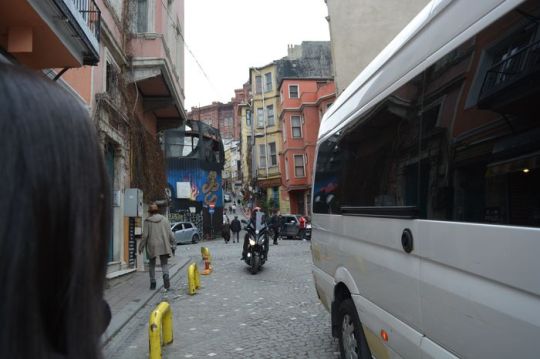
Embassy Buildings in Constantinople
All the European powers, including smaller countries like Holland and Belgium, have impressive embassy buildings in Constantinople (modern-day Istanbul). These buildings are not only elegant but also large and noticeable.
One of the most impressive is the German embassy, which is considered one of the finest buildings in the entire city. Only the palaces of the Sultan are larger or more majestic. The German embassy stands on a high, visible spot, and can be seen from many areas in the city.
The Russian embassy is also very large. It is surrounded by a high protective wall and includes its own hospital for the use of Russian staff and citizens. The British embassy is another fine example, built with care and elegance.
The American Minister’s Housing Struggles
Unlike the European countries, the United States does not own a proper embassy building in Constantinople. The American minister (ambassador) usually has to live in a hotel, because it is difficult—and sometimes even impossible—to find a suitable house to rent in the city.
At present, there is only one house available that might work. It belongs to an Italian nobleman who has gone back to Italy. The house is in a great location in one of the most convenient parts of the city. However, it has serious problems. The basement is always wet, and water seeps into the walls, making it an unhealthy and uncomfortable place to live. Because of this, it is unlikely that the American minister will rent it.
Summer Move to Therepia
Due to the extreme summer heat and pollution in Constantinople, most ambassadors and diplomats move to a cooler place during the hot months. The preferred location is Therepia, a small suburban town located a few miles up the Bosphorus.
On July 1st, all diplomatic staff and ambassadors leave the city and move to their summer legations in Therepia. They stay there until November 1st, when the weather becomes cooler and it’s safe to return to the city Guided Tour Ephesus.
Even while living in Therepia, the ambassadors and their secretaries often travel to the city during the day to attend meetings and conduct official business. Many governments provide their ambassadors with private yachts to travel easily between Therepia and Constantinople.
Lack of Support for the U.S. Minister
Unfortunately, the United States is the only major power that does not provide a yacht for its ambassador. During the summer, the U.S. minister is allowed to rent a small steam-powered boat, called a launch, to travel back and forth. But when the summer ends, this boat is returned to its owner, and the U.S. minister once again faces limited transportation options.
This lack of proper housing and transportation shows how under-supported the American diplomatic presence was in Constantinople compared to the well-established European embassies.
0 notes
Photo
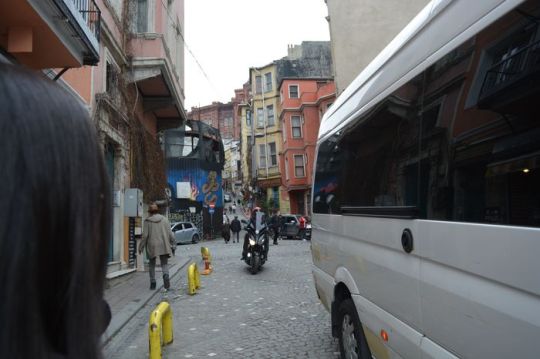
Embassy Buildings in Constantinople
All the European powers, including smaller countries like Holland and Belgium, have impressive embassy buildings in Constantinople (modern-day Istanbul). These buildings are not only elegant but also large and noticeable.
One of the most impressive is the German embassy, which is considered one of the finest buildings in the entire city. Only the palaces of the Sultan are larger or more majestic. The German embassy stands on a high, visible spot, and can be seen from many areas in the city.
The Russian embassy is also very large. It is surrounded by a high protective wall and includes its own hospital for the use of Russian staff and citizens. The British embassy is another fine example, built with care and elegance.
The American Minister’s Housing Struggles
Unlike the European countries, the United States does not own a proper embassy building in Constantinople. The American minister (ambassador) usually has to live in a hotel, because it is difficult—and sometimes even impossible—to find a suitable house to rent in the city.
At present, there is only one house available that might work. It belongs to an Italian nobleman who has gone back to Italy. The house is in a great location in one of the most convenient parts of the city. However, it has serious problems. The basement is always wet, and water seeps into the walls, making it an unhealthy and uncomfortable place to live. Because of this, it is unlikely that the American minister will rent it.
Summer Move to Therepia
Due to the extreme summer heat and pollution in Constantinople, most ambassadors and diplomats move to a cooler place during the hot months. The preferred location is Therepia, a small suburban town located a few miles up the Bosphorus.
On July 1st, all diplomatic staff and ambassadors leave the city and move to their summer legations in Therepia. They stay there until November 1st, when the weather becomes cooler and it’s safe to return to the city Guided Tour Ephesus.
Even while living in Therepia, the ambassadors and their secretaries often travel to the city during the day to attend meetings and conduct official business. Many governments provide their ambassadors with private yachts to travel easily between Therepia and Constantinople.
Lack of Support for the U.S. Minister
Unfortunately, the United States is the only major power that does not provide a yacht for its ambassador. During the summer, the U.S. minister is allowed to rent a small steam-powered boat, called a launch, to travel back and forth. But when the summer ends, this boat is returned to its owner, and the U.S. minister once again faces limited transportation options.
This lack of proper housing and transportation shows how under-supported the American diplomatic presence was in Constantinople compared to the well-established European embassies.
0 notes
Photo
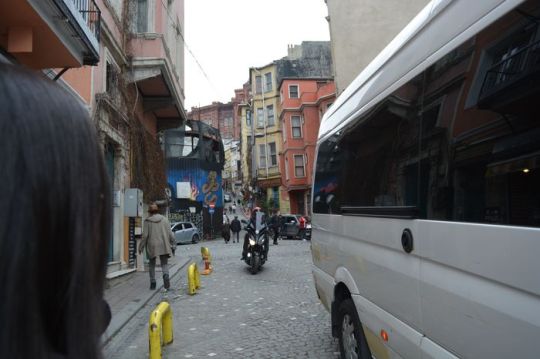
Embassy Buildings in Constantinople
All the European powers, including smaller countries like Holland and Belgium, have impressive embassy buildings in Constantinople (modern-day Istanbul). These buildings are not only elegant but also large and noticeable.
One of the most impressive is the German embassy, which is considered one of the finest buildings in the entire city. Only the palaces of the Sultan are larger or more majestic. The German embassy stands on a high, visible spot, and can be seen from many areas in the city.
The Russian embassy is also very large. It is surrounded by a high protective wall and includes its own hospital for the use of Russian staff and citizens. The British embassy is another fine example, built with care and elegance.
The American Minister’s Housing Struggles
Unlike the European countries, the United States does not own a proper embassy building in Constantinople. The American minister (ambassador) usually has to live in a hotel, because it is difficult—and sometimes even impossible—to find a suitable house to rent in the city.
At present, there is only one house available that might work. It belongs to an Italian nobleman who has gone back to Italy. The house is in a great location in one of the most convenient parts of the city. However, it has serious problems. The basement is always wet, and water seeps into the walls, making it an unhealthy and uncomfortable place to live. Because of this, it is unlikely that the American minister will rent it.
Summer Move to Therepia
Due to the extreme summer heat and pollution in Constantinople, most ambassadors and diplomats move to a cooler place during the hot months. The preferred location is Therepia, a small suburban town located a few miles up the Bosphorus.
On July 1st, all diplomatic staff and ambassadors leave the city and move to their summer legations in Therepia. They stay there until November 1st, when the weather becomes cooler and it’s safe to return to the city Guided Tour Ephesus.
Even while living in Therepia, the ambassadors and their secretaries often travel to the city during the day to attend meetings and conduct official business. Many governments provide their ambassadors with private yachts to travel easily between Therepia and Constantinople.
Lack of Support for the U.S. Minister
Unfortunately, the United States is the only major power that does not provide a yacht for its ambassador. During the summer, the U.S. minister is allowed to rent a small steam-powered boat, called a launch, to travel back and forth. But when the summer ends, this boat is returned to its owner, and the U.S. minister once again faces limited transportation options.
This lack of proper housing and transportation shows how under-supported the American diplomatic presence was in Constantinople compared to the well-established European embassies.
0 notes
Photo
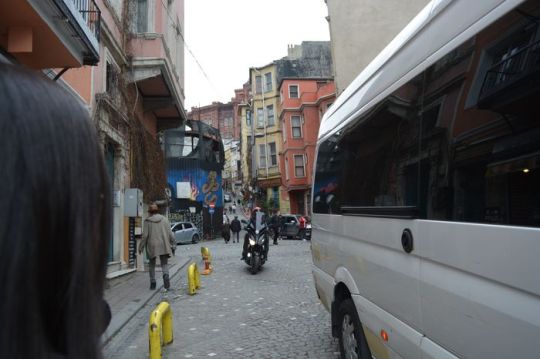
Embassy Buildings in Constantinople
All the European powers, including smaller countries like Holland and Belgium, have impressive embassy buildings in Constantinople (modern-day Istanbul). These buildings are not only elegant but also large and noticeable.
One of the most impressive is the German embassy, which is considered one of the finest buildings in the entire city. Only the palaces of the Sultan are larger or more majestic. The German embassy stands on a high, visible spot, and can be seen from many areas in the city.
The Russian embassy is also very large. It is surrounded by a high protective wall and includes its own hospital for the use of Russian staff and citizens. The British embassy is another fine example, built with care and elegance.
The American Minister’s Housing Struggles
Unlike the European countries, the United States does not own a proper embassy building in Constantinople. The American minister (ambassador) usually has to live in a hotel, because it is difficult—and sometimes even impossible—to find a suitable house to rent in the city.
At present, there is only one house available that might work. It belongs to an Italian nobleman who has gone back to Italy. The house is in a great location in one of the most convenient parts of the city. However, it has serious problems. The basement is always wet, and water seeps into the walls, making it an unhealthy and uncomfortable place to live. Because of this, it is unlikely that the American minister will rent it.
Summer Move to Therepia
Due to the extreme summer heat and pollution in Constantinople, most ambassadors and diplomats move to a cooler place during the hot months. The preferred location is Therepia, a small suburban town located a few miles up the Bosphorus.
On July 1st, all diplomatic staff and ambassadors leave the city and move to their summer legations in Therepia. They stay there until November 1st, when the weather becomes cooler and it’s safe to return to the city Guided Tour Ephesus.
Even while living in Therepia, the ambassadors and their secretaries often travel to the city during the day to attend meetings and conduct official business. Many governments provide their ambassadors with private yachts to travel easily between Therepia and Constantinople.
Lack of Support for the U.S. Minister
Unfortunately, the United States is the only major power that does not provide a yacht for its ambassador. During the summer, the U.S. minister is allowed to rent a small steam-powered boat, called a launch, to travel back and forth. But when the summer ends, this boat is returned to its owner, and the U.S. minister once again faces limited transportation options.
This lack of proper housing and transportation shows how under-supported the American diplomatic presence was in Constantinople compared to the well-established European embassies.
0 notes
Photo
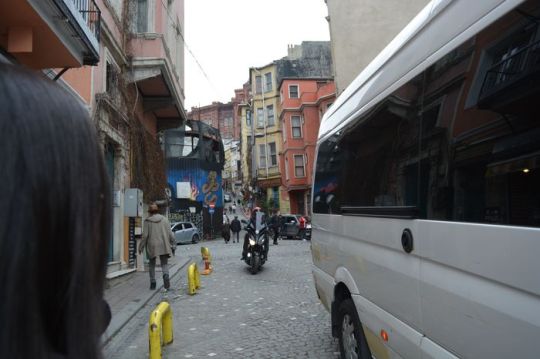
Embassy Buildings in Constantinople
All the European powers, including smaller countries like Holland and Belgium, have impressive embassy buildings in Constantinople (modern-day Istanbul). These buildings are not only elegant but also large and noticeable.
One of the most impressive is the German embassy, which is considered one of the finest buildings in the entire city. Only the palaces of the Sultan are larger or more majestic. The German embassy stands on a high, visible spot, and can be seen from many areas in the city.
The Russian embassy is also very large. It is surrounded by a high protective wall and includes its own hospital for the use of Russian staff and citizens. The British embassy is another fine example, built with care and elegance.
The American Minister’s Housing Struggles
Unlike the European countries, the United States does not own a proper embassy building in Constantinople. The American minister (ambassador) usually has to live in a hotel, because it is difficult—and sometimes even impossible—to find a suitable house to rent in the city.
At present, there is only one house available that might work. It belongs to an Italian nobleman who has gone back to Italy. The house is in a great location in one of the most convenient parts of the city. However, it has serious problems. The basement is always wet, and water seeps into the walls, making it an unhealthy and uncomfortable place to live. Because of this, it is unlikely that the American minister will rent it.
Summer Move to Therepia
Due to the extreme summer heat and pollution in Constantinople, most ambassadors and diplomats move to a cooler place during the hot months. The preferred location is Therepia, a small suburban town located a few miles up the Bosphorus.
On July 1st, all diplomatic staff and ambassadors leave the city and move to their summer legations in Therepia. They stay there until November 1st, when the weather becomes cooler and it’s safe to return to the city Guided Tour Ephesus.
Even while living in Therepia, the ambassadors and their secretaries often travel to the city during the day to attend meetings and conduct official business. Many governments provide their ambassadors with private yachts to travel easily between Therepia and Constantinople.
Lack of Support for the U.S. Minister
Unfortunately, the United States is the only major power that does not provide a yacht for its ambassador. During the summer, the U.S. minister is allowed to rent a small steam-powered boat, called a launch, to travel back and forth. But when the summer ends, this boat is returned to its owner, and the U.S. minister once again faces limited transportation options.
This lack of proper housing and transportation shows how under-supported the American diplomatic presence was in Constantinople compared to the well-established European embassies.
0 notes
Text
New Post has been published on
Embassy Buildings in Constantinople
All the European powers, including smaller countries like Holland and Belgium, have impressive embassy buildings in Constantinople (modern-day Istanbul). These buildings are not only elegant but also large and noticeable.
One of the most impressive is the German embassy, which is considered one of the finest buildings in the entire city. Only the palaces of the Sultan are larger or more majestic. The German embassy stands on a high, visible spot, and can be seen from many areas in the city.
The Russian embassy is also very large. It is surrounded by a high protective wall and includes its own hospital for the use of Russian staff and citizens. The British embassy is another fine example, built with care and elegance.
The American Minister’s Housing Struggles
Unlike the European countries, the United States does not own a proper embassy building in Constantinople. The American minister (ambassador) usually has to live in a hotel, because it is difficult—and sometimes even impossible—to find a suitable house to rent in the city.
At present, there is only one house available that might work. It belongs to an Italian nobleman who has gone back to Italy. The house is in a great location in one of the most convenient parts of the city. However, it has serious problems. The basement is always wet, and water seeps into the walls, making it an unhealthy and uncomfortable place to live. Because of this, it is unlikely that the American minister will rent it.
Summer Move to Therepia
Due to the extreme summer heat and pollution in Constantinople, most ambassadors and diplomats move to a cooler place during the hot months. The preferred location is Therepia, a small suburban town located a few miles up the Bosphorus.
On July 1st, all diplomatic staff and ambassadors leave the city and move to their summer legations in Therepia. They stay there until November 1st, when the weather becomes cooler and it’s safe to return to the city Guided Tour Ephesus.
Even while living in Therepia, the ambassadors and their secretaries often travel to the city during the day to attend meetings and conduct official business. Many governments provide their ambassadors with private yachts to travel easily between Therepia and Constantinople.
Lack of Support for the U.S. Minister
Unfortunately, the United States is the only major power that does not provide a yacht for its ambassador. During the summer, the U.S. minister is allowed to rent a small steam-powered boat, called a launch, to travel back and forth. But when the summer ends, this boat is returned to its owner, and the U.S. minister once again faces limited transportation options.
This lack of proper housing and transportation shows how under-supported the American diplomatic presence was in Constantinople compared to the well-established European embassies.
0 notes
Text

@suburbanbeatnik The most egregious one I can think of is The Eagle and the Swan—the POV character is a celibate monk named Fabianus who grew up in the Hippodrome alongside Theodora, and who works as a scribe/artist/writer under Procopius in the palace. The framing device of the novel is that Theodora has enlisted Fabianus to write her biography, and in practice, this means that there are a bunch of scenes where Theodora is just, like, splashing around in the bath and stripping off her clothes while loudly describing her sexual escapades. (For her official biography, you see.) Fabianus is, of course, super in love with her, and they have that kind of childhood-friends-to-lovers dynamic, but they obviously can't actually become lovers because she's married to Justinian and he's a monk (and possibly a eunuch, too, I don't remember). Justinian's not depicted as a total asshole, but he is pretty dismissive and rude towards Theodora, and there are like five different scenes where something horrible happens to Theodora and she's crying, and Fabianus is left to comfort her because Justinian won't step up.
Three-Headed Serpent and The Color of Power by Marie Heese pretty much cast Narses as the Pathetic Guy, too—like, Narses is really devoted to Theodora and distantly in love with her, and he's obsessed with protecting her and keeping her safe, but obviously, he can never really have her because he's a eunuch and she's married to his boss. It's very "courtly love," if that makes sense. He has all of these internal monologues where he calls her "my lady" and talks about how cute she is and daydreams about having her for himself. Justinian isn't that bad at first, but he becomes steadily shittier over the course of the second book, especially after he gets the plague—there's this little subplot where Theodora basically rules the empire while he's busy being comatose, then he wakes up and recovers, and he's upset that Theodora has "unmanned" him or something. So Theodora goes away to her little palace across the Bosphorus and gets really sick, and by the time she comes back to Constantinople, she's on the verge of death. Justinian is upset by this, but also totally useless and unhelpful, and it's Narses who ends up taking care of Theodora because once again, Justinian won't step up. Ultimately, Theodora dies holding Narses's hand because Justinian couldn't stand to be with her at the end.
Fortune's Child and Too Soon the Night by James Conroyd Martin also used this trope—the main character is a eunuch named Stephen who was a friend of Theodora's before she met Justinian, and—surprise surprise—Stephen is now working in the palace under Procopius. Once again, the framing device of the duology is Theodora asking Stephen to write her biography. I feel kind of bad lumping these books in with The Eagle and the Swan, because they're way classier (there are no cringeworthy scenes where Theodora describes being sexually abused while seductively eating fruit in the bath, for one) and Stephen is much more likeable than Fabianus. But they're definitely built on the same set of tropes—the POV character is still a eunuch who wants Theodora but can't have her, Theodora still is very close to him, and there's still the vague implication that they could've had a romantic connection if things were different. Justinian isn't really an asshole in this duology, and Stephen isn't as much of a shitty niceguy type, so I view these books more fondly. But they're still very much Pathetic Guy POV character books, lol.
And then, of course, there's Maxentius, my beloathed. (I know you've read this one, but for the benefit of my readers: Maxentius is about yet another childhood friend-turned-servant of Theodora, except instead of being a monk or a eunuch, he's romantically unavailable because he's married to Anastasia, Theodora's younger sister. He's sexually obsessed with Theodora, and Theodora flirts with him constantly, so there are like a dozen illustrations depicting a nude or semi-nude Theodora staring at the reader with bedroom eyes. Hilariously, Maxentius reiterates over and over again that his actual wife, Anastasia, is but a pale imitation of Theodora—but all of the women are drawn to look so similar to one another that you can hardly even tell Anastasia and Theodora apart.) It's very much cut from the same cloth as all of these other stories—they have that childhood-friends-to-lovers energy, and it's implied that Maxentius could've married Theodora if she hadn't gotten involved with Justinian first, but now she's Justinian's empress, and everyone involved is resentful about that. I don't know if Justinian has a particuarly dickish personality in this one, but he's definitely drawn to look as unattractive as possible compared to Maxentius, who's built like a Ken doll. And Maxentius does the same thing as Fabianus, Stephen, and (Heese's version of) Narses, where he's constantly thinking about protecting Theodora and envisioning himself as her lover.
Another important part of the Shitty Theodora Book Ecosystem that I forgot to mention is a very specific subtype of romance-ish (?) novel I’ve dubbed the “Pathetic Guy” novel.
Basically, the main character of the Pathetic Guy novel is the eponymous Pathetic Guy, a good-looking and good-hearted young man who’s desperately in love with Theodora, but inaccessible to her for some reason (he’s typically either a eunuch or a monk/priest, or he’s married). The Pathetic Guy is obsessed with Theodora, and Theodora never really feels the same way about him, but she always flirts with him and propositions him for shits and giggles. So there are a bunch of super sexualized scenes where she’s, like, in the bath or getting dressed or getting a massage or something, and she’s deliberately torturing the Pathetic Guy by seducing him from afar while simultaneously letting him know that he can never actually have her. (Usually, the Pathetic Guy goes home and fantasizes about her, which gives the author/illustrator an excuse to include even more sexual content and explain it away by saying that it’s just happening in his dreams or something.) Sometimes there are hints that Justinian is an asshole and that Theodora would be better off with the Pathetic Guy, but, like, women be gold diggers, amirite? So the Pathetic Guy is always thinking “gee, I’d treat her well, but women just don’t appreciate nice guys these days.” And this goes on for a while until Theodora dies, at which point the Pathetic Guy is the only one who’s there for her on her deathbed because every other guy in the world is so meaaannnnn and he’s the only one who really cared about her and she would’ve known that if she had given the nice boy a chance.
#I could've sworn I'd read another book with this same plot but the name is currently escaping me#(they all kind of blend together after a while)
13 notes
·
View notes
Text
Sigurd you're acting kind of Cult-leader-like, what--
OH SHIT. WAIT. When do we find out the Prophecy? I mean, do we know when it was first figured out? I know its from ACII and the Brotherhood and Order both know it and apparently (IIRC) it said that the prophet is the person who appeared at a certain place at a certain time. (With the Apple? I don't remember clearly, it's been legit yeeeears since I played ACII.)
Was the Prophecy known at this point, 874 CE? When it mentions a location, does it say specifically Venice in the late 1400s, or is it more mystical like "At a city of/on/surrounded by water, at a time of great prosperity"? Well, in comparison to the West Roman Empire (RIP) at this point.
In other words: does Basim think that Sigurd is the prophet?????
#meco livefails acv#because Constantinople is built on the Bosphorus#i distinctly remember a lot of Things in Revelations re: water#not as much as ACIII or later installments but#more than the previous games!#and Basim met Sigurd in Constantinople#I NEED TO PLAY MORE#I NEES MORE DETAAAAAILS
0 notes
Text
The Rise and Fall of Empires
After an uneventful day of transit, we landed quite late in Turkiye and were rushed quickly to dinner before we pulled in at the hotel that we would be staying at in Istanbul: the Pullman. On the two hour flight from Cairo to Istanbul (for most of the day, we simply sat around the hotel before hopping onto the coach that would deliver us to the airport at 10AM), I managed to watch Bullet Train and tick off the chaotic but fun movie from my long list of films that had looked interesting but I hadn’t bothered to go into the cinemas to actually well...watch.
In any case, by the time I had showered and fallen asleep on the soft bed at the Pullman, it was quite late and we had an early start the next day.
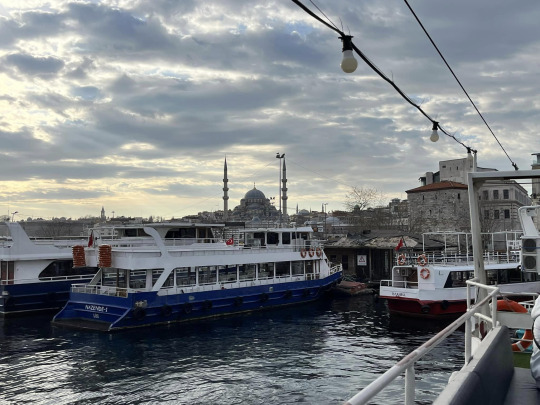
At about 6:35AM, I was rudely awoken by a morning wake-up call and served as a reminder that I was late! Popo and I came down for a hurried breakfast before boarding the coach that would take us around the ancient city of Istanbul, or Constantinople as it was previously known during the Byzantine and Ottoman eras.
We arrived at our first stop for the day: a decently sized marine vessel, just before 9AM. Hopping on, we enjoyed a cruise around the Bosphorus Strait, providing us with excellent views of the city of Istanbul. It should be known that the city straddles the bridge between Europe and Asia and has proven to be a pivotal beacon throughout most of history. It played a key role in Christianity before it fell to the Ottomans and became an Islamic stronghold.
As such, the history of Constantinople is really a history of the world, as well as a symbol of the West’s relationship with the East.
But back to a recount of my trip there!
It was unfortunate that we had arrived in the city in March. The weather was still quite cool and after a good thirty minutes, I felt quite frozen to my spot on the upper deck and quickly sought shelter from the fierce wind.
After our trip on the high seas, our ship pulled into port near the Dolmabahce Palace. In Chinese, the palace is often called the “New Palace” as it was built in and around the mid 1800s and was in use for approximately 70 years until the 1920s when Turkiye became independent.
The style of the Dolmabahce Palace, although commissioned by an Ottoman Sultan, was very European in design. However, this was soon explained by the fact that the architect for the palace had studied in France and had helped build similar types of buildings all across Europe.
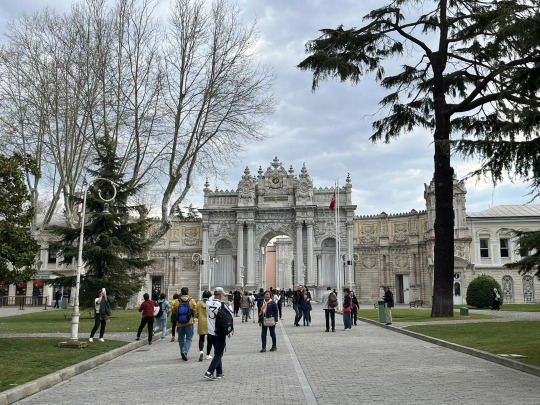

Still, the decorations inside the palace was a lot different to the ones I’d seen before in France and Austria. A shame, really, that photos were not allowed as I could show you rather than be forced to describe what I saw. Even though there were a few other tourists that took quite a few ‘subtle’ photographs of the rooms and the grand ceremonial hall.
Most notable, at least to me, were the paintings that lined the walls. Most of them depicted famous battles the Turks partook in. Another interesting piece of interior design that caught my eye was the crystal staircase, with the crystal primarily being the supporting columns of the banister.
Down in the old storage cellars, too, the palace sported numerous displays full of utensils compromised of Bohemian and Baccarat crystals. They also had Mosser glass, which the internet tells me can cost thousands of dollars because of their high-quality construction. Another location in the heart of the palace had displays for medals, weapons and Hokka sets.
But it should be noted that the palace also had similar trappings as its European counterparts such as the gilded halls, lavish drapings, huge mirrors, as well as beautiful chandeliers. Which will serve as useful material for my future writings although I lack photos for reference.
After touring the Dolmabahce Palace, we had a quick lunch in a spot that was, no doubt, frequented for its water views and which served as a popular fishing spot.
With our stomachs full of grilled fish, we headed to the Grand Bazaar, established all the way back in 1481 according to the plaque out front. There, we roamed the shops and I exchanged some Australian and American dollars into Turkish lira. And though there was a leather jacket I dearly wanted to purchase, my funds, unfortunately, did not have enough stretch to allow me to buy it out right. Nor did I want to risk using my debit card for fear that the details would be stolen and used for nefarious purposes.
Good riddance, I say! I didn’t want it anyways...
Maybe...
Gosh, I do wish I had bought that reversible leather jacket!
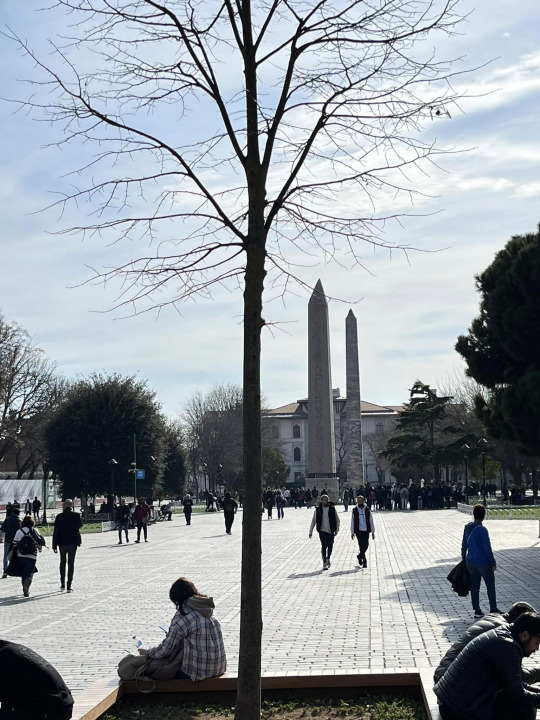
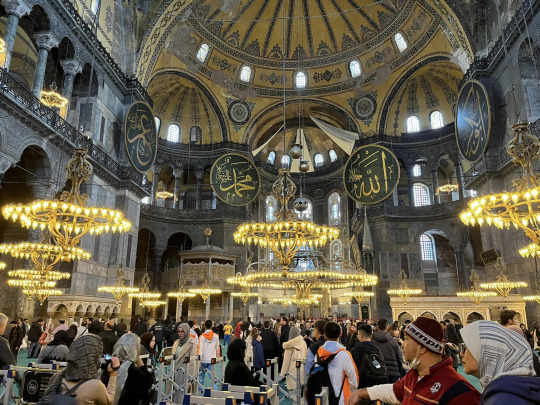
Once I had established how useless I was at haggling, we headed to the Blue Mosque, which sat opposite the Hagia Sophia. Due to ill luck, visiting on a Friday of all days, the Blue Mosque was closed by the time we arrived. It was also undergoing renovations. This fact angered one member of the tour group who was quite rude and aggressive to our tour guide for fear that we would miss out on all the key locations on the itinerary.
What he didn’t know, of course, was that the itinerary had already been rejigged when we had paid a visit to the Dolmabahce Palace earlier and we would have plenty of time upon our return to Istanbul to take a gander around a mosque if we so wished (which did happen, although it wasn’t the Blue Mosque!).
Undaunted by the trantrum thrown, the tour guide continued to tell us about the Roman Hippodrome that had been constructed in the heart of Istanbul and why the only signs of its presence was the obelisk that had been taken from Karnak Temple. Of course, we had already seen its twin when we visited Karnak Temple several days ago when we had given Egypt a whirl. Score one for a well-planned trip!
We then headed to the Hagia Sophia, which was initially built as a Church following the conversion of the Roman Empire to Christianity. The Hagia Sophia was later converted into a mosque when the Turks took the city. When Turkiye became independent, it served temporarily as a museum before being converted back into a mosque.
And to think that such a sight had been built in a mere 5 years!
True, a lot of the material, such as the Grecian columns used to support the roof, had been recycled from older buildings like a Temple to Artemis in the Ephesus region, but it still looked and felt like a marvel of engineering and vision.
The day ended with dinner at a doner kebab place before we headed back to our hotel for another long day ahead. Although, this time, we would mostly be on the road.
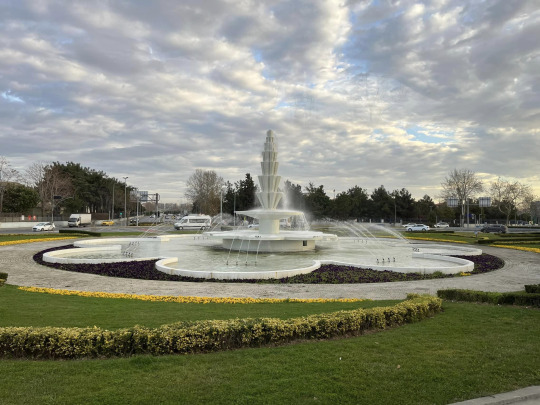

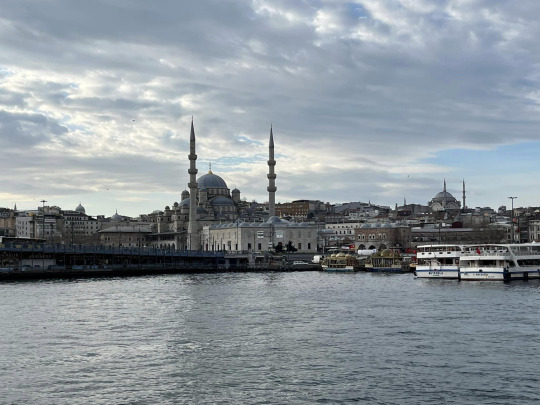
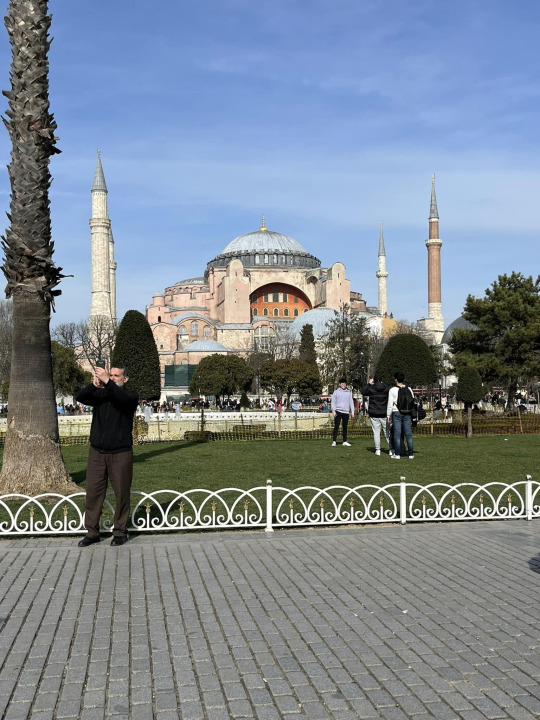
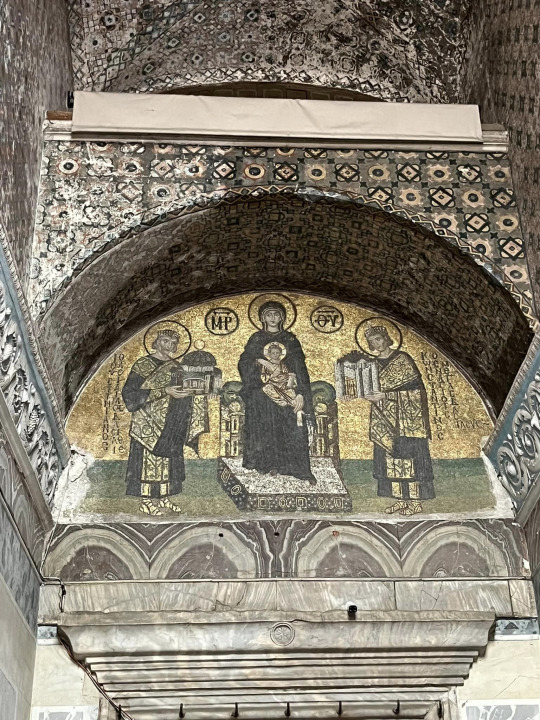
#travel blog#turkey#istanbul#constantinople#grand bazaar#bosphorus strait#dolmabahce palace#hagia sophia#hippodrome
3 notes
·
View notes
Text
Saints&reading: Thu., Mar. 25, 2021
Commemorated on March 12_by the new calendar
The Monk Theophanes the Confessor (818)
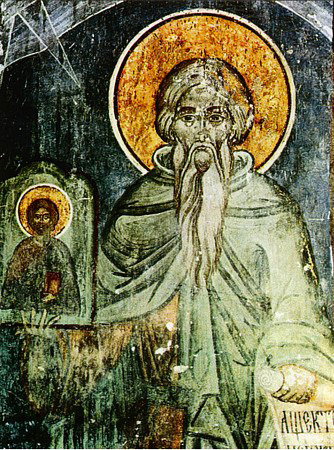
The Monk Theophanes the Confessor was born at Constantinople into a pious and reknown family. the father of Theophanes was a kinsman of the Byzantine emperor Leo the Isaurian (717-741). Three years after Theophanes was born, his father died, leaving his family under the care of the emperor himself. Theophanes grew up at the court and became a dignitary under the emperor Leo the Khozar (775-780). His position obliged him to enter into marriage. With the consent of his bride, Theophanes preserved his chastity, since in his soul matured the desire to assume the monastic form. Visiting upon a time with his spouse at monasteries in the Sygreian district (Asia Minor), Theophanes met the perspicacious elder Gregory Stratitios, who predicted to Theophanes' wife, that her husband would merit the crown of martyrdom. Awhile later the spouse of Theophanes was tonsured a nun in one of the monasteries in Bithynia, and Theophanes accepted monastic tonsure under the monastic elder Gregory. With the blessing of the elder, Theophanes built a monastery on the Island of Kalon in the Sea of Marmara and secluded himself in his cell, being occupied with the transcription of books. And in this occupation Theophanes attained an high degree of mastery. Later on the Monk Theophanes founded yet another monastery in the Sygreian district, at a place called the "Big Settlement", and became its hegumen. The monk himself took part in all the monastic tasks and for everyone he gave example by his love for work and effort. He was granted by the Lord the gift of wonderworking: he healed the sick and cast out devils. In the year 787 at Nicea was convened the Seventh Oecumenical Council, which condemned the heresy of the Iconoclasts. The Monk Theophanes was also invited to the Council. He arrived dressed in his patch-tattered attire, but he shone forth by his God-inspired wisdom in affirming the dogmas of the true Orthodoxy. At age 50 the Monk Theophanes fell grievously ill and right up to his very end he suffered terribly. Situated on his sick-bed, the monk toiled incessantly: he wrote his work, "The Chronographia", – an history of the Christian Church covering the years 285-813. This work even up into the present has remained an invaluable source in the history of the Church. During the reign of the emperor Leo the Armenian (813-820), when the saint was already well up into age, the Iconoclast heresy made a comeback. They demanded of Saint Theophanes that he accept the heresy, but he firmly refused and was locked up in prison. His "Big Settlement" monastery was put to the torch. In prison for 23 days, the holy confessor died (+ 818). After the death of the impious emperor Leo the Armenian, the "Big Settlement" monastery was restored and the relics of the holy confessor were transferred there.
© 1996-2001 by translator Fr. S. Janos.
The Monk Simeon the New Theologian (1022)
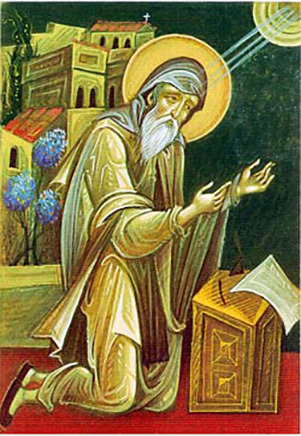
The Monk Simeon the New Theologian was born in the year 946 in the city of Galata (Paphlagonia), and he received the basic secular education at Constantinople. His father prepared him for a career at court, and for a certain while the youth occupied an high position at the imperial court. But at age 25 he felt the draw towards monastic life, and he fled his house and withdrew to the Studite monastery, where he entered into obedience under the then reknown elder Simeon the Reverent. The basic ascetic deed of the monk was the unceasing Jesus Prayer in its short form: "Lord, have mercy!" For greater prayerful concentration he constantly sought out solitude, and even at liturgy he stood separately from the brethren, and he often remained alone at night in the church; in order to accustom himself to mindfulness concerning death, he would spend nights in the graveyard. The fruit of his fervour was a special condition of ecstasy: in these moments the Holy Spirit in the form of a luminous cloud descended upon him and made oblivious to his sight everything surrounding. With time he attained to a constant high spiritual enlightened awareness, which was especially evident when he served the Liturgy.
In roughly the year 980 the Monk Simeon was made hegumen of the monastery of Saint Mamant and continued in this dignity for 25 years. He set in order the neglected management of the monastery and restored order to its church. The Monk Simeon combined kindliness with strictness and steadfast observance of the Gospel commands. Thus, for example, when his favourite disciple Arsenios killed ravens which were pecking away at moist bread, the hegumen made him tie the dead birds to a rope, and wear this "necklace" on his neck and stand in the courtyard. In the monastery of Saint Mamant for the atoning of his sin was a certain bishop from Rome, unrepentingly having murdered his young nephew, and the Monk Simeon assiduously brought him around to good and spiritual attentiveness. The strict monastic discipline, which the Monk Simeon constantly strove for, led to a strong dissatisfaction amongst the monastic brethren. One time after liturgy, the particularly irked among the brethren pounced on him and nearly killed him. When the Constantinople patriarch expelled them from the monastery and wanted to hand them over to the city authorities, the monk obtained pardon for them and aided them to live in the world. In about the year 1005, the Monk Simeon handed over the hegumen position to Arsenios, while he himself settled nearby the monastery in peace. He composed there his theological works, fragments of which entered into the 5 volumed "Philokalia" ("Dobrotoliubie"). The chief theme of his works – is the hidden activity of a spiritual perfecting, with struggle against the passions and sinful thoughts. He wrote discursive instructions for monks, – "Practical Theological Chapters", "A Tract on Three Forms of Prayers", and "A Tract on Faith". Moreover, the Monk Simeon was an outstanding churchly poet. To him belong the "Hymns of Divine Love" – about 70 poems, filled with profound prayerful ponderings. The teachings of the Monk Simeon about the new man, about the "divinisation of the flesh", with which he wanted to replace the teachings concerning the "mortification of the flesh" (for which also they termed him the New Theologian), – were difficult for his contemporaries to assimilate. Many of his teachings sounded for them unacceptable and strange. This led to conflict with Constantinople church authorities, and the Monk Simeon was subjected to banishment. He withdrew to the coasts of the Bosphorus and founded there a monastery of Saint Marina. The saint reposed peacefully to God in the year 1021. While still during his life he received a gift of wonderworking. Numerous miracles occurred also after his death; one of them – was a miraculous discovery of his image. His Life (Vita) was written by his cell-attendant and disciple, the Monk Nikita Stethatos.
© 1996-2001 by translator Fr. S. Janos.
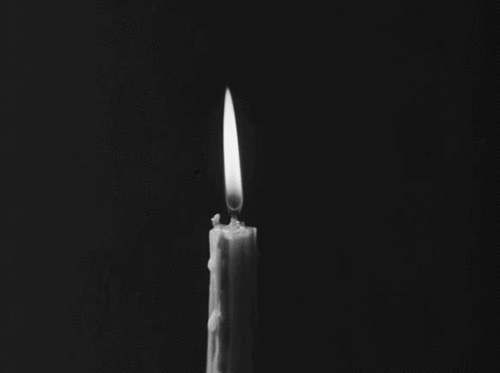
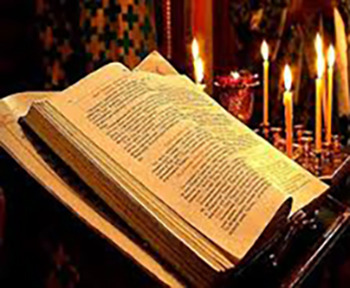
Isaiah 6:1-12
1 In the year that King Uzziah died, I saw the Lord sitting on a throne, high and lifted up, and the train of His robe filled the temple.
2 Above it stood seraphim; each one had six wings: with two he covered his face, with two he covered his feet, and with two he flew.
3 And one cried to another and said: “Holy, holy, holy is the Lord of hosts; The whole earth is full of His glory!”
4 And the posts of the door were shaken by the voice of him who cried out, and the house was filled with smoke.
5 So I said: “Woe is me, for I am undone! Because I am a man of unclean lips, And I dwell in the midst of a people of unclean lips; For my eyes have seen the King, The Lord of hosts.”
6 Then one of the seraphim flew to me, having in his hand a live coal which he had taken with the tongs from the altar.
7 And he touched my mouth with it, and said: “Behold, this has touched your lips; Your iniquity is taken away, And your sin purged.”
8 Also I heard the voice of the Lord, saying: “Whom shall I send, And who will go for Us?” Then I said, “Here am I! Send me.”
9 And He said, “Go, and tell this people: ‘Keep on hearing, but do not understand; Keep on seeing, but do not perceive.’
10 “Make the heart of this people dull, And their ears heavy, And shut their eyes; Lest they see with their eyes, And hear with their ears, And understand with their heart, And return and be healed.”
11 Then I said, “Lord, how long?” And He answered: “Until the cities are laid waste and without inhabitant, The houses are without a man, The land is utterly desolate,
12 The Lord has removed men far away, And the forsaken places are many in the midst of the land.
Proverbs 6:3-20
3 So do this, my son, and deliver yourself; For you have come into the hand of your friend: Go and humble yourself; Plead with your friend.
4 Give no sleep to your eyes, Nor slumber to your eyelids.
5Deliver yourself like a gazelle from the hand of the hunter, And like a bird from the hand of the fowler.
6Go to the ant, you sluggard! Consider her ways and be wise,
7 Which, having no captain, Overseer or ruler,
8 Provides her supplies in the summer, And gathers her food in the harvest.
9 How long will you slumber, O sluggard? When will you rise from your sleep?
10 A little sleep, a little slumber, A little folding of the hands to sleep—
11 So shall your poverty come on you like a prowler, And your need like an armed man.
12 A worthless person, a wicked man, Walks with a perverse mouth;
13 He winks with his eyes, He shuffles his feet, He points with his fingers;
14 Perversity is in his heart, He devises evil continually, He sows discord.
15 Therefore his calamity shall come suddenly; Suddenly he shall be broken without remedy.
16 These six things the Lord hates, Yes, seven are an abomination to Him:
17 A proud look, A lying tongue,
18 A heart that devises wicked plans, Feet that are swift in running to evil,
19 A false witness who speaks lies, And one who sows discord among brethren.
20 My son, keep your father’s command, And do not forsake the law of your mother.
#ortohdoxy#orthodoxchristianity#ancientchristianity#originofchristianity#ancientestament#sacred texts#wisdom
3 notes
·
View notes
Text
The Rise of the Ottomans in Istanbul
By Mark Huggins, ANAMED PhD Fellow (2019–2020)

My entry on the ANAMED blog takes a look at the new Netflix docudrama: Rise of Empires—Ottoman, a second effort following on its last docudrama on czar Nicholas II Romanov of Russia (reviews of that series were mixed; the Guardian wasn’t kind (https://www.theguardian.com/tv-and-radio/2019/jul/11/the-last-czars-netflix-historical-drama-that-the-whole-of-russia-is-laughing-at), but the Daily Beast raved (https://www.thedailybeast.com/the-last-czars-inside-netflixs-stunning-russian-answer-to-the-crown).
All 6 episodes of Ottoman were made available for streaming on Netflix this past Friday, 24 January. The reviews I’ve found published so far have been positive ( https://www.thereviewgeek.com/riseofempires-ottoman-s1review/, https://www.hitc.com/en-gb/2020/01/24/rise-of-empires-ottoman-netflix-narrator-charles-dance-actor/, https://www.thecinemaholic.com/rise-of-empires-ottoman-netflix/, https://readysteadycut.com/2020/01/24/rise-of-empires-ottoman-netflix-review/) and at least one ANAMED fellow was watching the series yesterday and seemed to be thoroughly entertained. Having watched the episodes myself, and being an enthusiast of period pieces generally, my opinion of the series is also positive overall. Each 45-minute episode addresses a particular theme/step in the process of Sultan Mehmed II’s (Fatih Sultan Mehmed) eventual capture of the capital of the Byzantine Empire, Constantinople. The series draws on both modern accounts and ancient, both Byzantine and Ottoman. The format is further supplemented by breaks in the historical dramatization to receive background information and explanations from scholars on the period.
Being a fellow at ANAMED this year has decisively influenced the way I viewed this series because over the last few months I have had the opportunity to explore this living treasure chest of past civilizations, and to the series’ credit, it is filmed on site here in Istanbul (though, of course, special effects and constructed sets are also employed). Generally, I’ve been fortunate; since I have studied in nearby Thessaloniki, I managed to visit Istanbul a few times before coming to ANAMED. Nevertheless, I never even scratched the surface compared to what I’ve experienced and learned now (and I certainly haven’t even scratched the surface this time, either, in relation to what the city has to offer). That being said, my time here has afforded me the opportunity to visit some of the monuments and sites mentioned in the series—of course, with the knowledgeable and pleasant company of other fellows! For example, episode 1 takes a look at Mehmed II’s bold construction (in 4 months!) of Rumelihisarı. I visited the site last October, currently located just north of the scenic Bebek neighborhood on the European side of the Bosphorus. Mehmed II’s construction of the fortress sent a message to Constantinople that he was coming.

image credits: Stavroula Valtadorou
This by itself wasn’t enough to necessarily unnerve either Constantine XI, the reigning Byzantine emperor at the time (and the last one, of course), or any of his predecessors. As the series repeatedly notes, many armies had come and gone, falling either dead or else impotent at the impenetrable fifth-century Theodosian Walls. It had been common knowledge among Byzantine rulers for centuries that, when all else failed, Constantinople would withstand any possible attack. Hold the city and you’re emperor. This was what Mehmed II’s father, Murad II, had learned the hard way back in 1421. The Byzantines didn’t need superior forces (which was good because they hadn’t had any for a long time); their diplomacy was enough as long as the walls held, and a well-timed revolt or challenge to the throne was usually enough to make massive armies disappear. Murad II had better luck in Thessaloniki, which he captured in 1430. He immediately proceeded to convert the Panagia Acheiropoietos Church (built in late 5th century) into a mosque, and his seal commemorating his victory and thanking Allah can still be seen in the now functioning church to this day.
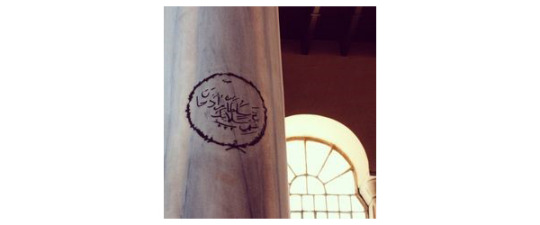
image credit: https://gr.pinterest.com/pin/510947520199763166/?d=t&mt=login
The series does a good job of explaining Mehmed II’s motivation in taking Constantinople, as well as the factions within his own Court that sought to undermine him. Since his father, Murad II had failed, Mehmed II was determined to succeed. In order to do so, though, he needed superior technology, and this is precisely what he procured in the form of the legendary “basilica” canons, which did eventually manage to breach Constantinople’s famed defenses. In Edirne, capital of the Ottoman Empire at the time, a monument commemorates Mehmed II’s victory, complete with a replica of some of his cannon.

image credits: ANAMED PhD fellows Jeffrey Haines and Athanasios Sotiriou
The story that Rise of Empires—Ottoman tells is full of detail and vivid imagery, making it accessible to anyone (even Byzantinists (!), who are usually trained to stop thinking of anything past 1453…) All in all, this mini-series is enjoyable, engaging and, if you’re an ANAMED fellow, yet another reminder to get out there and explore this incredible city and country that is full to the brim with historical treasures everywhere you look. My stay at ANAMED has made this experience come alive for me like never before, interacting with both the place and the people, especially benefiting from the extensive knowledge of other fellows. The series by no means replaces the in-person, hands-on experience of the city, but for anyone not yet fortunate enough to have been here, perhaps it will provide the impetus you need to make the effort to visit and explore. I highly recommend the series, because, if for nothing else, it reminds us fellows of what we enjoy every day throughout these 9 months and may serve as an initiation for others to come and experience the same one day.
I am grateful to all the fellows who helped with this post by providing pictures and/or background information to supplement my (embarrassingly almost non-existent) knowledge of the Ottoman Empire: Betül Kaya, Ibrahim Mansour, Jeffrey Haines, Athanasios Sotiriou, and Stavroula Valtadorou (my fellow!).
1 note
·
View note
Text
Mystical city where the continents meet: Istanbul
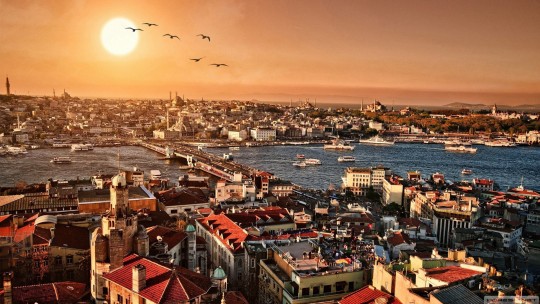
Istanbul... The city where the continents meet... Historical, magical, impressive but also crowded, noisy and stressful for its residents... With its more than 15 million population Istanbul is the 4th largest city in the whole world and biggest one in Turkey of course. You will find detailed information in this Istanbul city guide.
Istanbul City Guide
Short History of Istanbul
Istanbul has its own unique long-standing history. So any of the Istanbul city guides must have some fragments about its own great history. The first inhabitant of Istanbul is dating back to almost 2nd millennium BC. They have settled the Asian side of the city at that time. Back in time, Istanbul got its first name around the 7th century which is Byzantium, a Greek name for a city on Bosphorus. Around the 6th century, BC Alexander the Great took the city and peace period started for almost 200 years for this unique place. Roman Empire In year 193 a Roman emperor Septimus Severus conquered the city remained under the Roman rule until the 4th century AD. The historical name of Istanbul which is Constantinople was given by the Constantine the Great around 5th century AD after the separation of Roman Empire to Western and Eastern Roman (Byzantium) and the city is called to the capital of Byzantine Empire. At that time the city was built over the 7 hills but it's another story. Constantinople's population rise up to almost half a million between 4th and 6th century. Also during that time, the great wonder has risen in Constantinople, Hagia Sophia! Constantinople have the number of sieges, riot and plunder during history...
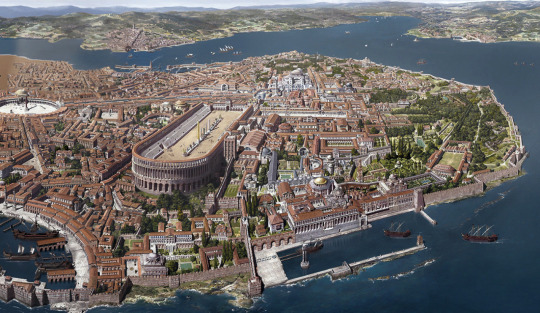
Constantinople, as it appeared in the 13th century, here accurately depicted by Antoine Helbert. (Source: https://tr.pinterest.com/pin/114841859222847086/) Ottoman Turks Constantinople conquered by the Sultan Mehmet II in 1453 with 53 days of siege and city named to Islambol, became the capital of Ottoman Empire. During the next 200 years many mosques, baths, madrasahs and public houses built by the sultans. With the investments to the city and peace period give a change to the city to regain its population up to half a million once more. Throughout the centuries the name of the evolve to the Istanbul. During World War I the Great War city was occupied by the allied troops until the national struggle which led by the father of Turks the Mustafa Kemal Atatürk repel them. After the birth of the Republic of Turkey in 1923 capital moved to Ankara. But during time Istanbul has continued to grow and expand drastically, today its population over 15 million one of the biggest cities in the whole world and unfortunately, it continues to grow...
How to Get to Istanbul
Istanbul geographically has various advantages. You can take a flight from more than 300 cities to Istanbul by Turkish Airline which globally recognized. If you want a more nostalgic route to reach Istanbul you can take international trains from the Balkan to reach the city. There are two airports in Istanbul which are Istanbul Airport on the European side (opened in 2019 instead of the old one: Istanbul Ataturk Airport) and Sabiha Gokcen Airport on the Asian side. Unfortunately, both of the airports don't have a metro line at that time and you have to take a bus or taxis. You can find information about how to get from airport to city in both ways. These airports almost 80 km away from each other. So we can say that both of them location two sides of Istanbul. Just be careful before taking a taxi! Try to use Uber-like apps to not deal with scams and overcharges. Istanbul Airport's web site in English Sabiha Gokcen Airport's web site in English
Public Transport in Istanbul
Istanbul has really advanced public transport system. Metros, trains, trams, buses, ferries and taxis... In Istanbul, you have to buy an Istanbul card to use public transport. You can buy it from the terminals in the airport or various selling points around the city. You can find the main website for Istanbul's public transport. İstanbul Metropolitan Municipality İETT (Buses) Metro Istanbul Şehir Hatları (Ferry Lines) Marmaray (Suburb train line) In Istanbul its quite easy to reach your target destination by using metros, trams, train ve ferries but not buses! There is huge traffic both during morning and evening rush times. So try to use rail systems most of the time to get around the city. Most populated and touristic areas have metro or trams so it won't be a problem for you to get these places. In Istanbul, rail and sea transport mostly serves between 06.00 and 00.00 but also night lines for the buses. You can use night buses to go to most of the places in Istanbul, just don't forget to check the timetables.
Top 10 Places to Visit in Istanbul
There are countless places to see in Istanbul and you will discover a new one every time you came back to this great city but we just wrote down 10 of them. 1. Hagia Sophia (Aya Sofya) This legendary landmark always gets the first place in Istanbul city guide. There is a phrase about Byzantine Emperor Justinian when he entered the Hagia Sophia in 536 AD, he cried and said that I have outdone you, Solomon! At that time Hagia Sophia is one of the greatest wonders all over the world and still is. When the Sultan Mehmet II conquered the city he converted Hagia Sophia to the mosque and construct four minarets. Hagia Sophia served as a mosque until the 24 October 1934. After this date, Hagia Sophia became of one of the most famous museums in Turkey. Ticket price for visiting the Hagia Sophia is around 60 TL for the full fare. Hagia Sophia Museum Website
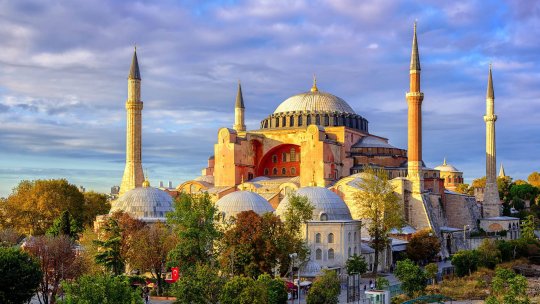
Hagia Sophia Museum (Source of the image) 2. Sultan Ahmet Mosque (Blue Mosque) Blue Mosque or Sultan Ahmed Mosque is a historical wonder just in front of the Hagia Sophia. This mosque called as "blue" because of the surrounding walls of the interior. Blue Mosque was built between years 1609-1616 by the Ottoman Sultan Ahmed I. Blue Mosque is an open and active for the Muslim prayers during the days. Because of this if you go there during praying times you may need to wait 15-20 minutes to enter the inside. You will get a free scarf before entering the mosque from the staff and don't believe anyone who offers you to get in the mosque without waiting for the queue. By the way visiting the mosque is totally free.
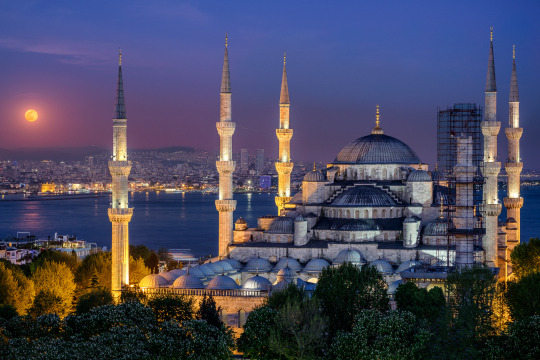
Blue Mosque (Source of the image) 3. Topkapı Palace Palace was both homes of the Ottoman Sultans and administrative/educational centre of the empire. After the conquest of Istanbul palace was built by the Sultan Mehmed II between 1460 and 1478. Palace actively served until the 1850s for the state affairs until it became inadequate for the protocols and other things until the sultans moved to Dolmabahçe Palace. New sections added to the palace through years by the sultans. The landmark has a total area around 700.000 square meters and its major area located in the Royal Gardens which is in Turkish, Hasbahçe. Topkapı Palace Museum Website
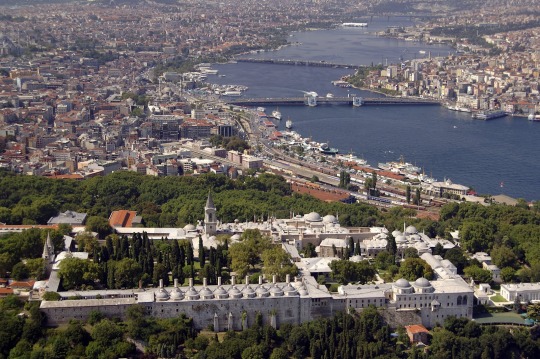
Topkapı Palace Museum (Source of the image) 4. Basilica Cistern Basilica Cistern is one the Istanbul's splendid historical places. This large underground cistern was built by the Byzantine Emperor Justinian between the 527 and 565 as a water reservoir. The cistern is 140 meters long and 70 meters wide like a rectangle structure and it has 336 marble columns. It has the capacity to hold around 100.000 tons of water. There are also Medusa head from the Roman time which is a great example of the great artwork. The Basilica Cistern Website
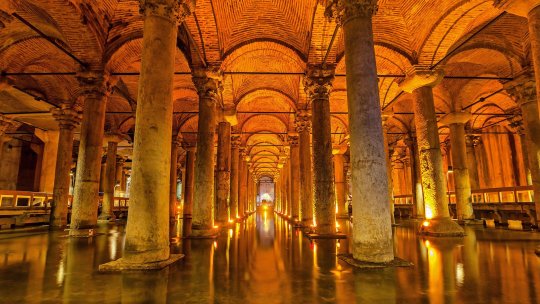
Basilica Cistern (Source of the image) 5. Galata Tower Tower has a panoramic view of Istanbul's historical peninsula as well as the surroundings.63 meters high tower was built by the Genoese colony around the 14th century for the defence of the Galata district and its located directly opposite of the ancient Constantinople. Also during the Ottoman reign, Hazerfan Ahmet Çelebi was the first Turk who overflew the Bosphorus to Üsküdar for more than a 6000 meters in distance.
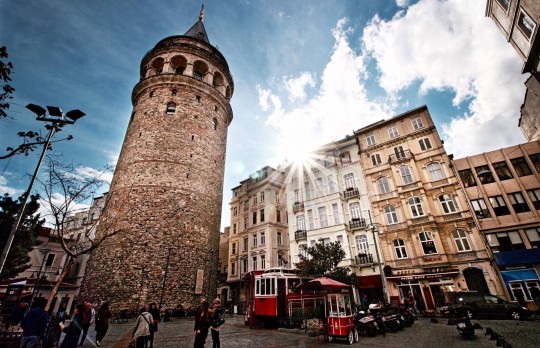
Galata Tower (Source) 6. Grand Bazaar Here is one of the most-to-see places in Istanbul city guide. Grand Bazaar is the largest covered market in the world! It has various of goods buyers which make it more and more famous. Grand Bazaar's covered area is around 30.700 square meters with more than 60 streets and 4000 shops. Enormous! The bazaar was constructed by Sultan Mehmed II after the conquest and during the years it also expands by the following sultans.
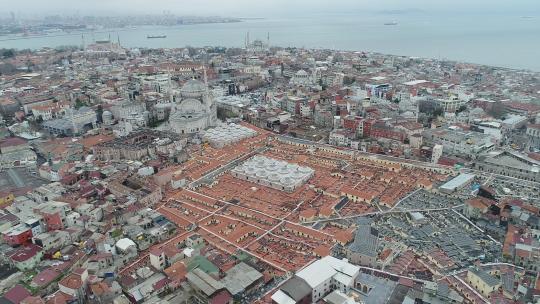
Grand Bazaar (Source) 7. Prince Islands Prince Island is a combination of nine islands on the Asian side of Istanbul. You can take ferries to the islands from Kadıköy, Bostancı and few other places. There no motorized vehicle on the island except for the police, fire and health departments. Four of the islands are the biggest ones; Büyükada, Heybeliada, Burgazada and Kınalıada. "Prince" name comes from the Byzantine period when the royal family members exiled to these islands. There were also largely Jewish, Greek and Armenian on islands. 8. İstiklal Street and Taksim Square Taksim Square and İstiklal Street are two of the most famous and known places in İstanbul. Many hotel and restaurant located in these areas and liked by the tourists. There is an Independence Monument in Taksim Square which is located the entrance of the İstiklal Street. Also, I new mosque is being constructed a couple of years which is also located in the square and its quite nice one. There is a historical tramline serves between Taksim Square to Şişhane. You can find there the world 2nd oldest metro line serves from Şişhane to Karaköy which name is "Tünel" in Turkish. Metro, funicular and bus lines go through the Taksim and Şişhane which makes them very easy to reach and get around.
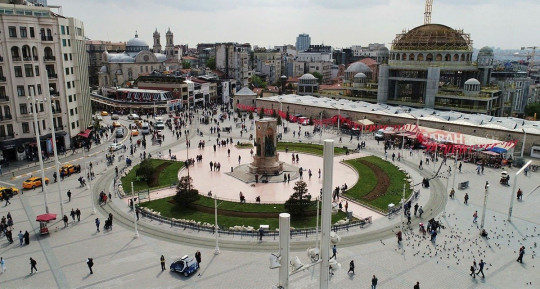
Taksim Square and Mosque on the background (Source) 9. Üsküdar Most of the Istanbul city guide ignores or neglects the Asian side but it has its own beauties. Üsküdar is located on the Asian side of the İstanbul and it is located the entrance to the Bosphorus. The district has a long history back in days to the Ottoman Sultan Orhan Gazi years around 1352 before the conquest of İstanbul. During the Ottoman period, Üsküdar was one the judgeship of İstanbul. People who come from the Anatolia resided in Üsküdar after it was taken by Organ Gazi. During the 17th century, there were around 70 Muslim, 11 Greek and Armenian neighbourhoods. There is also Kızkulesi (Maiden's Tower) just the shore of Üsküdar which has history long-standing history from the Byzantine.
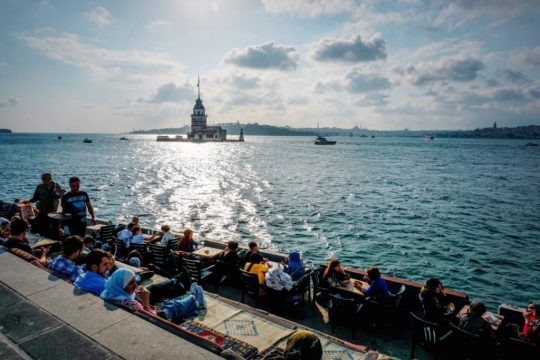
Maiden's Tower (Source) 10. Istanbul Archaeology Museum This is one of the best museums in Istanbul. It is located at the Topkapı Palace. The museum complex has three main sections which are Museum of the Ancient Orient, the Archaeology Museum and the Tiled Pavilion. The museum gets the collections from beginning of the 19th century by the museum director, archaeologist Osman Hamdi Bey.
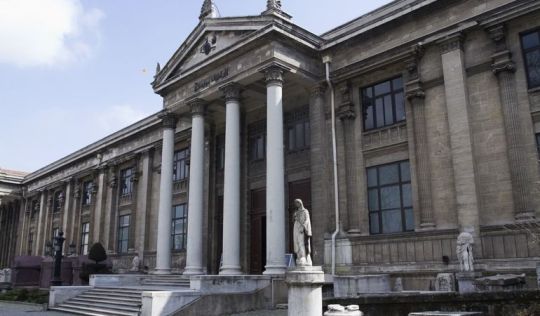
Entrance of the Istanbul Archaeology Museum (Source) How long the Istanbul city guide will it be never enough for a city like this... Just let yourself to discover its unique beauties... Turkey is visa-free for most of the countries. You should think to visit Istanbul and probably you won't regret this decision. Don't hesitate to leave your comment for the people who're planning to go there or already there! We will improve this Istanbul city guide together. Read the full article
2 notes
·
View notes
Text
Istanbul, Türkiye
August 23-26, 2022
We spent 2 full days and 3 nights in Istanbul - a city of 15.5 million people and I think we saw most of them OMG!!! We continue to have a great time and although I do am still fighting with my vision, I have decided that the best vision I can get right now is to go without glasses and let my repaired eye do the work - which means no reading of any kind. I still can't get used to seeing myself without glasses - but there you go...
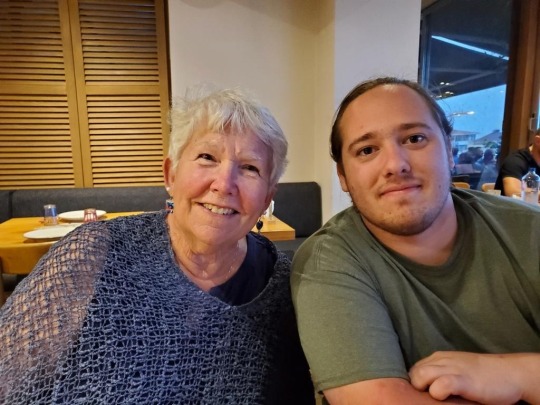
Istanbul is a major city in Türkiye that straddles Europe and Asia across the Bosphorus Strait. It is the only city spanning 2 continents. It is not the capital of Türkiye. - but it is the financial capital of Türkiye.

The Bosphorus Strait is of great significance because it is the only way out of the Black Sea. You can see how strategic it is especially to Ukraine AND Russia. I have marked the area where the Ukrainian grain is stored that feeds the world and is being held up by Russia.

We had a day of touring and a day on our own. The disappointment for me was that we could not get in the Blue Mosque because it is under renovation. Mark and I have seen it, but Kepler has not and it is awe-inspiring. Here is what we WOULD have seen had we been able to get in....

We spent the day going visiting the Hagia Sophia. The Hagia Sophia was built by the eastern Roman Emperor Justinian as the Christian Cathedral of Constantinople for the state of the Roman Empire the between 532 and 537. It was a church, then a mosque, then a museum and has recently been returned to a mosque. (The current president of Türkiye, President Erdoğan, it on a tear trying to make this country a Muslim country although the government and religion are constitutionally separate - just like in the US. But he has an idea how the country should lean Muslim INSTEAD of being neutral... hmmmmm - sound familiar?)

The Hagia Sophia is exquisite!! Mark and I visited several years ago on our own, but having an expert drawing your attention to this or that was so helpful and certainly enhanced the visit. The first Hagia Sophia was built in the 4th century largely by Constantinius II (even though some credit Constantine the Great with starting construction) who upon its completion patted himself on the back and declared it the most beautiful building ever built.
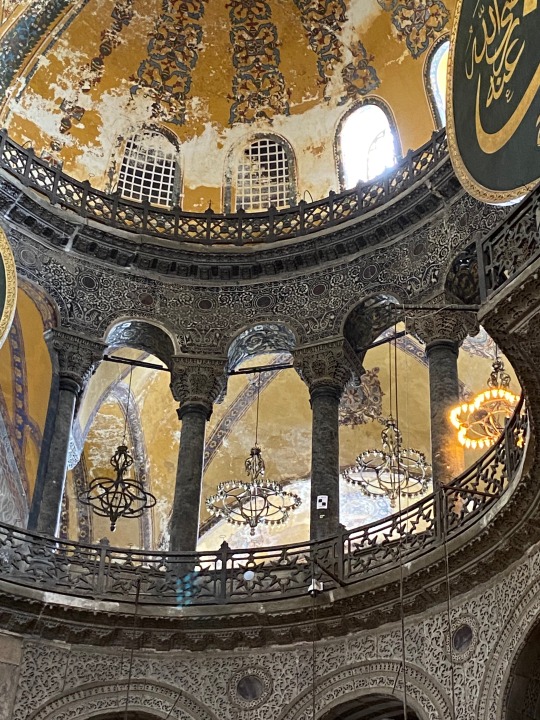
A few years after its completion, it burned to the ground. The only remnant of the original building is the stone baptismal. Theodosius II then began construction of the second version in the early 5th century, and that second Hagia Sophia lasted 115 years before it also burned down. In the year 532, just a few weeks after the second fire, Emperor Justinian I began construction of a bigger, better church on the same grounds. He decided that this time there would be no wood in the structure. The building burned twice already, and he wanted this final version to last.
Over 10,000 people were involved in the construction of this third church. The massive number of tradespeople involved led to the completion of the exterior of this massive structure in just under six years, although work on the interior continued for several more years, including breathtaking gold mosaics that cover the interior.
The Hagia Sophia has a fascinating history beyond its multiple constructions. It was first an Orthodox cathedral. After the invasion of the Crusaders in the 13th century, it became a Roman Catholic cathedral. Once the Ottomans conquered Constantinople (now Istanbul) in the 15th century, it was transformed into a mosque. When it became a mosque, all the mosaics and Christian symbols were plastered, painted, or covered with cloth. In the early 20th century, the building became a “museum,” but - well you know. Currently many of the works that were exposed are covered with a "stupid curtain" to quote Salih - but they have not yet been plastered over. Salih believes once the president is voted out this building will return to being a museum.
The floors are once again covered with carpet but the walls are original and largely preserved, and they date all the way back to the 6th century. They are covered with slabs of marble that are mirror images of each other - which usually means FAKE. But not here. I did not understand how difficult creating this was until Salih explained.
In order for the pattern to flow from one piece of marble to the next, the craftsmen had to “slice off” very thin slabs (an inch or less) from a larger piece. They took these thin slabs and flipped them back and forth so the grain matched up. As he explained it, I became even more impressed, He reminded us that this work was done 1,500 years ago.
The answer: silk, sand, and olive oil. These panels are cut SLOWLY using silk thread and a little help from the other items.
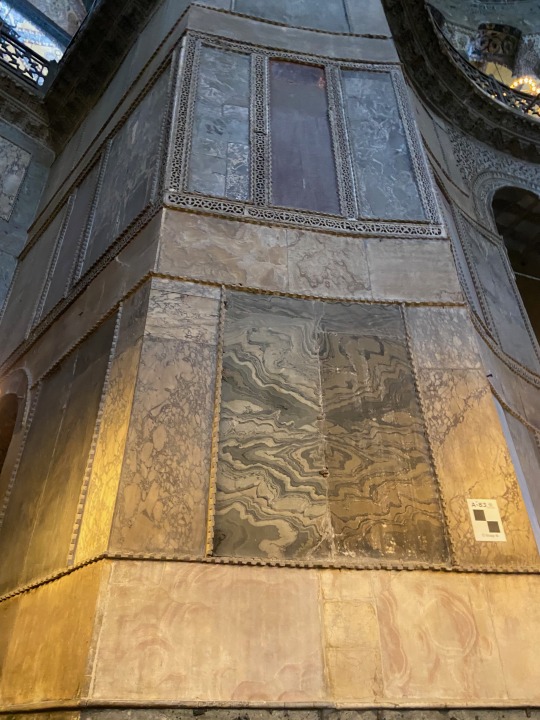
I'm not kidding either. I mean WOWZA!!!
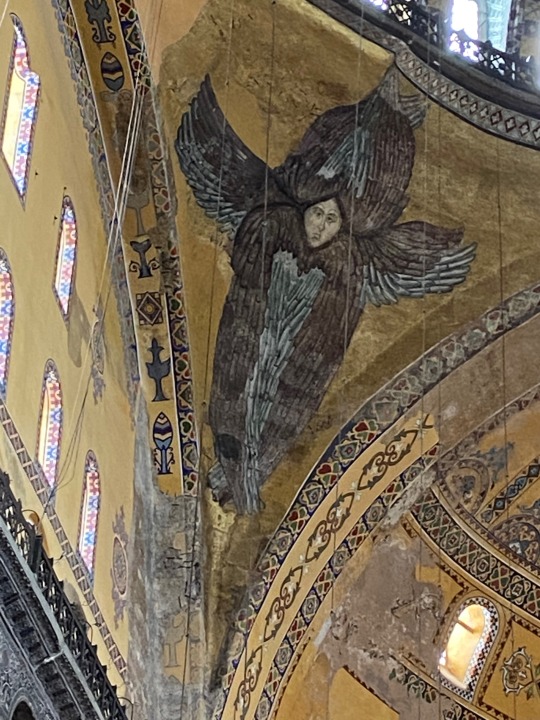
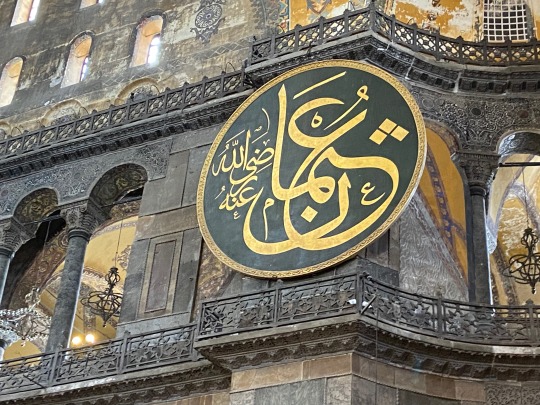
Quite stunning!
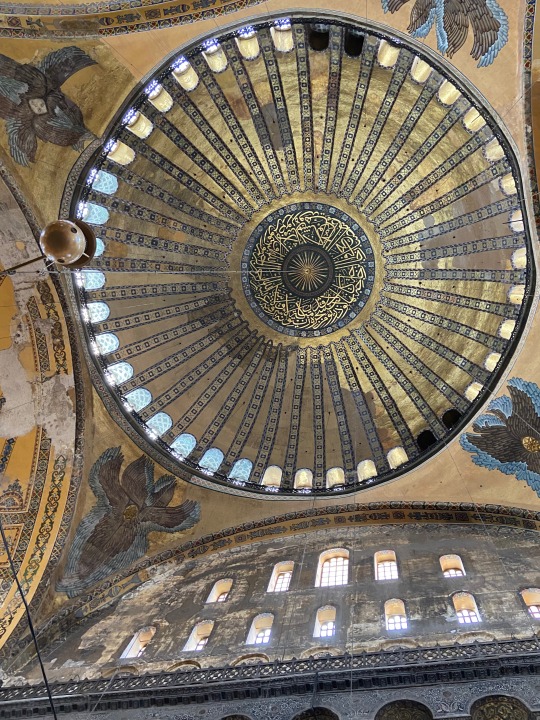
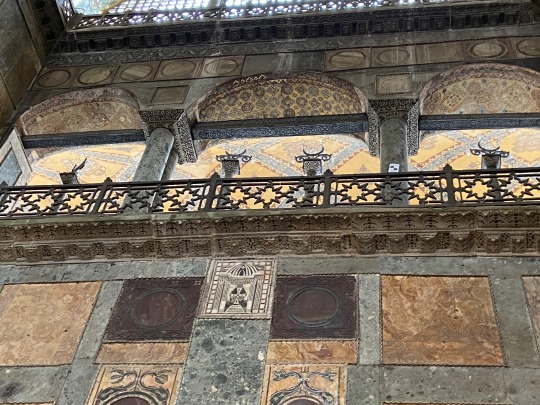
Of course, as one would expect, we learned a great deal. Muslims believe that Jesus was a prophet and as his mother, Mary is highly revered. She is often prayed to by pregnant women, women who wish to be pregnant or have children that are suffering or ill. Her pictures are still in the Church/Mosque/Museum/Mosque including this....
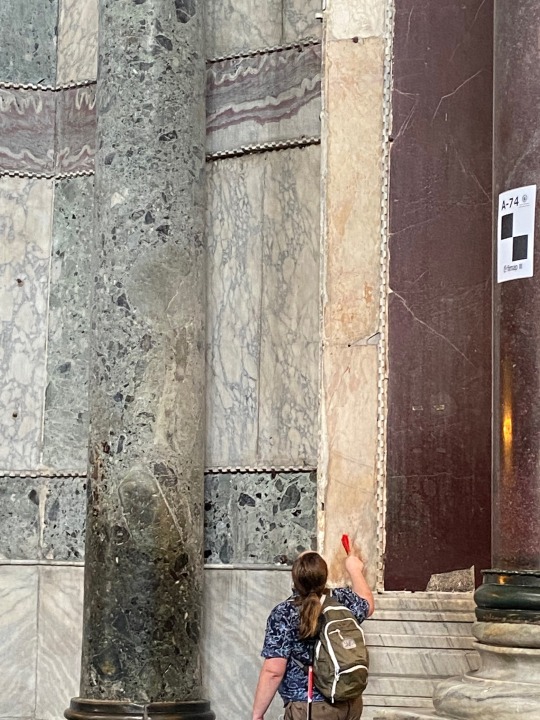
Mary's real and true handprint. Ponder that for a minute!
We spent about an hour in the Hagia Sophia and it was HOT. Even hotter if you were wearing a headscarf.
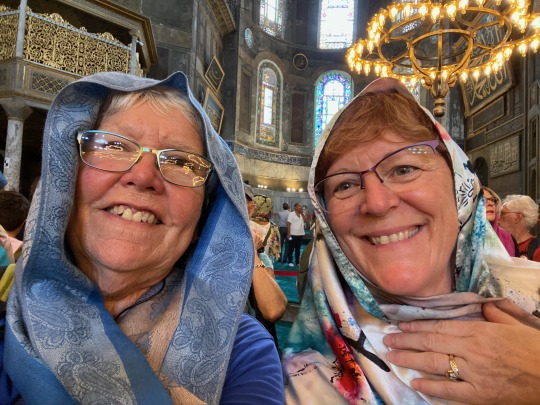
As beautiful as the place was - we were more than happy to leave and get these scarves off our heads. It is exquisite
Next - Topkapi Palace. Stay tuned.
0 notes
Text
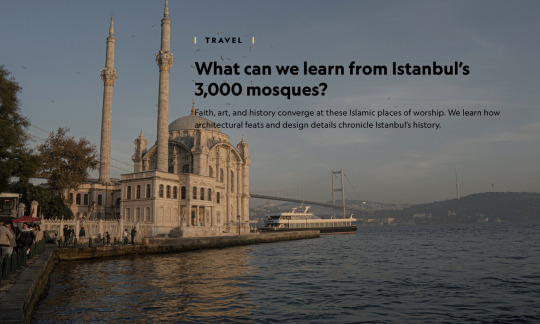
ORTAKÖY MOSQUE: The Ortaköy Mosque, officially the Büyük Mecidiye Camii, was completed in 1854 in the Beşiktaş district on the Bosphorus Strait. The legendary city of Istanbul is filled with mosques which tell stories dating from the Roman, Byzantine, and Ottoman empires to today. Photograph By Alba Cambeiro, Photojournalist based in Istanbul
— Text By Allie Yang | March 30, 2022
Stories of devotion, pride, and artistry live within the walls of Istanbul’s mosques. There are more than 3,000 of these places of worship in Turkey’s largest city, ranging from grand edifices on sprawling grounds to unassuming wooden buildings just off the city street.
Some were originally constructed as Byzantine churches, dating back to the fourth century A.D., and new mosques continue to be erected regularly. Whether contemporary or ancient, Istanbul’s mosques demonstrate tremendous variety: some feature soaring domes and are filled with patterned tile and calligraphy, while others are sleek, minimal, and modern.
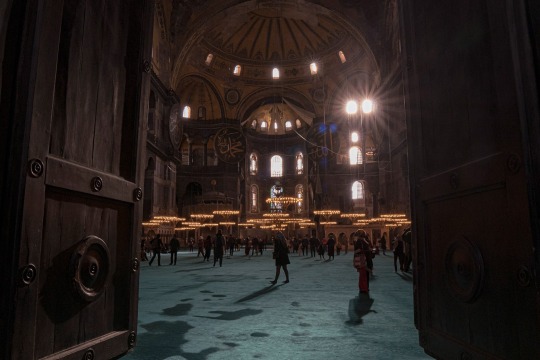
HAGIA SOPHIA: Built by Byzantine emperor Justinian I in the sixth century A.D., the Hagia Sophia originally served as the Orthodox Christian cathedral of Istanbul (known then as Constantinople). Located in the city’s Sultanahmet neighborhood, the iconic building has also served as a Catholic church, mosque and museum in its nearly 1,485-year lifetime.
The city’s mosques nurture their communities, exhibit art and craftsmanship, and many of them honor the longstanding tradition of welcoming outsiders to witness the practices of Islam’s faithful. This article draws on a conversation with Ünver Rüstem, a historian of Islamic art and architecture who has written extensively on Istanbul’s mosques.
Mosques in the Seat of Empires
Stepping into mosques can transport travelers to ages past and tell stories of the rise and fall of the Roman, Byzantine, and Ottoman empires.
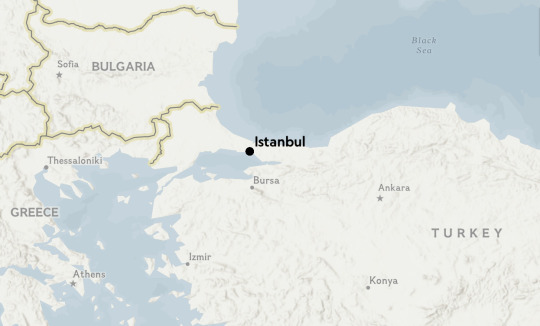
Before electricity, many mosques were illuminated by low-hanging lamps with flickering oil-fed flames that blanketed the rooms in golden light. The spacious prayer hall would have been covered with handwoven carpets in a variety of colors, mainly red. Regardless of the size of the space, worshippers would pray shoulder-to-shoulder. Before the advent of deodorants, the smell of burning incense sweetened the air. Unlike some sects of Christianity, incense was never required for liturgy.
Today, mosques are lit with electric bulbs, and often feature a machine-made baby blue carpet. Incense is no longer burned. Yet the prayers of the devoted that fill these halls follow long-established rituals.
Muezzins, chanters who perform the centuries-old tradition of calling worshippers to prayer, create one of the most ubiquitous sounds of the city. Before each of the five daily prayers, the voices of muezzins can be heard layering and intertwining with each other.
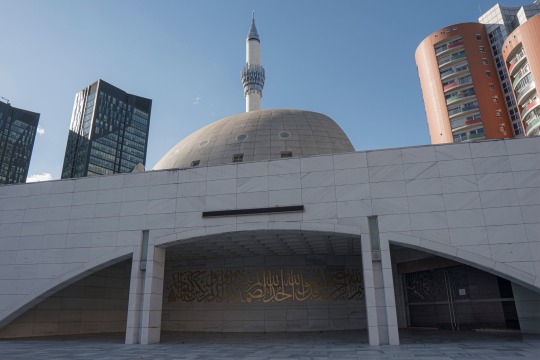
YEŞİLVADİ MOSQUE: The circular, modern shapes of the Yeşilvadi Mosque represent the universe, infinity, and unity. It was built in 2004.
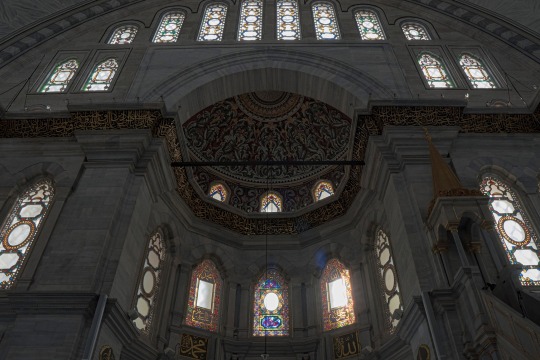
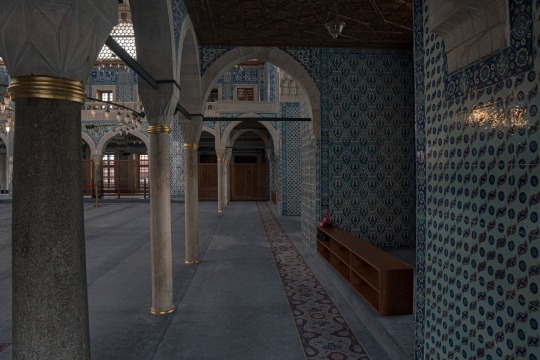
LEFT: NURUOSMANİYE MOSQUE! Completed in 1755, the Nuruosmaniye Mosque is located east of the Grand Bazaar in Istanbul’s Çemberlitaş neighborhood. The complex also contains a madrasa (school), imaret (soup kitchen), tomb, library, and sebil (kiosk for water distribution). RIGHT: RÜSTEM PASHA MOSQUE! Near the Spice Bazaar in the Tahtakale district, the Rüstem Pasha Mosque was designed by famed Ottoman architect Mimar Sinan. The structure stands out among Sinan’s mosques and others in the city because of how extensively its interior is decorated with tiles from İznik.
Nowadays, the calls to prayer (ezan in Turkish, adhan in Arabic) are broadcast through loudspeakers mounted on the minarets, towers that can reach hundreds of feet in height. In the past, you’d hear only what a muezzin’s voice could carry on the wind. The chanters would climb to balconies atop the minarets and cup their hands around their mouths to better broadcast their calls.
Famously straddling Europe and Asia, Istanbul was host to different powerful cultures and religions. Roman Emperor Constantine founded the city in A.D. 330; the city was christened “Constantinople” in his honor and known as such until 1930 when it was officially renamed Istanbul, the city’s historic Turkish name. When the Roman Empire split in 395, the city became the capital of the Eastern Roman (Byzantine) Empire and a hub of Christianity—until Ottoman Sultan Mehmed II captured the city in 1453. The Muslim Turks of the Ottoman empire proceeded to convert churches to mosques around the city and build mosques of their own.
Mosques were often named after the patron who funded them, and the structure’s grand presence became a physical expression of the patron’s political power or social status. There were unwritten rules about how grand a mosque could be— for example, only members of the Ottoman royal family were permitted to build more than one minaret.
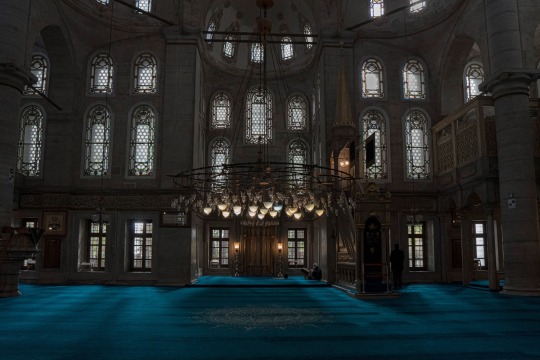
EYÜP SULTAN MOSQUE: The Eyüp Sultan Mosque is one of the holiest and most important mosques in all of Turkey, located outside the old city walls near the Golden Horn. Abu Ayyub al-Ansari, standard-bearer and close friend of the Prophet Muhammad, is said to have been buried there.
In the early 1600s, Sultan Ahmed I caused something of a scandal by breaking another rule, which was that only sultans who were successful in war should build grand mosques.
He proposed building a new mosque just across from the most famous mosque in the city, the converted cathedral of Hagia Sophia, without a conquest to justify it. His counselors advised against it, but he built it anyway. Today, the Sultan Ahmed Mosque, or “Blue Mosque,” is one of the most iconic buildings in the world, with an astounding total of six minarets. Four centuries later, it remains Ahmed’s most notable legacy.
Displays of Art and Craftsmanship
In addition to gathering the faithful, Istanbul’s mosques showcase works of beauty and feats of engineering to people from around the world.
Domes on the grandest mosques in Istanbul could symbolize the heavens and the realm of God, but like the minarets, their size was also a way to assert power. The main dome of the Süleymaniye Mosque, built in the mid-16th century by Sultan Süleyman the Magnificent, is 86 feet in diameter and reaches a height of 174 feet, taller than the Arc de Triomphe in Paris by 12 feet.
The architect behind the Süleymaniye Mosque was the renowned Mimar Sinan, who went on to serve a further two sultans after Süleyman. Responsible for dozens of Istanbul’s mosques and other buildings, Sinan is one of the most notable figures in the city’s architectural history.
With strict rules in the past about how a patron could build their mosques, tilework became a way to bypass codes of decorum. A small, humble mosque that couldn’t use enormous domes and minarets could dazzle worshippers with intricate craftsmanship. One such building is the late 16th-century mosque of the cap maker Takkeci İbrahim Agha, whose otherwise modest mosque is filled with magnificent multicolor tiles brought from İznik.
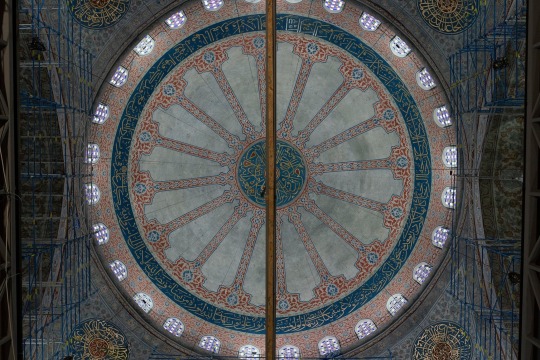
SULTAN AHMED: The Sultan Ahmed Mosque’s nickname “Blue Mosque” comes from the blue hue given off by the thousands of İznik tiles in geometric and floral designs that decorate its walls. The structure features four half domes around its main central dome, as well as hundreds of panels of stained glass.

LEFT: SÜLEYMANİYE MOSQUE! The Süleymaniye Mosque was designed by Mimar Sinan in the 1550s for Süleyman the Magnificent. Its location on the city’s Third Hill provides an expansive view of the city around the Golden Horn. For 462 years, the mosque was the largest mosque in the city, until it was surpassed by the Çamlıca Mosque in 2019. RIGHT: NEW MOSQUE! The New Mosque at the southern end of the Galata Bridge is 350 years old. Safiye Sultan, the wife of Sultan Murad III, commissioned the building at the end of the sixteenth century. However, the project was abandoned and not completed until the 1660s, when Hadice Turhan, Queen Mother of Mehmed IV, took over the site. The original architect was Davut Ağa, an apprentice to Mimar Sinan.
The town of İznik, 85 miles southeast of Istanbul, became famous in the 1500s for its tile industry. The glazed ceramic tiles made there featured botanical motifs such as tulips, carnations, and vines, some of which were influenced by the Chinese porcelain treasured along the Silk Road.
Passages from the Quran adorn the buildings both inside and out in both painted and carved calligraphic script. They didn’t need to be read to be meaningful—even those worshippers unable to decipher the Arabic would have admired these inscriptions as beautiful renderings of God’s holy word.
Welcoming Community
Mosques were meant to leave visitors with a memory of a patron’s greatness, the magnificence of the city of Istanbul, and the glory of the religion of Islam. Historically, non-Muslim visitors could gain access to the city’s main mosques without much difficulty; today, tourists are freely welcomed.
Mosques used to be the center of complexes that contained baths, schools, hospitals, libraries, and kitchens to feed the poor. Today, baths and drinking fountains in some mosques still function. Other structures have been converted for modern needs, including cafés and offices.
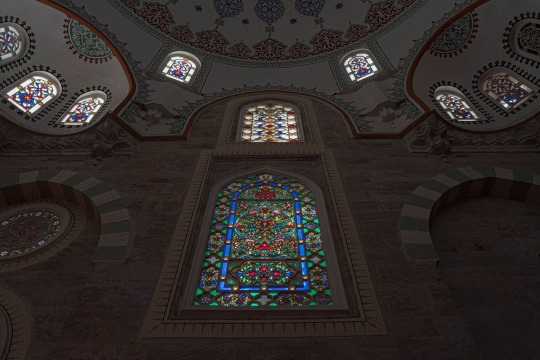
MİHRİMAH SULTAN MOSQUE: The Mihrimah Sultan Mosque is a 16th-century building located in the Edirnekapı neighborhood, near the highest point in the city. In contrast to stained glass in Christian churches that often depict figures and stories, Islamic stained glass uses botanical and geometric designs.
The patrons who funded these complexes were sometimes laid to rest in a separate tomb building within the complex. Visitors could pay their respects, and the investors netted dividends in the afterlife.
One might assume these mosques would be quiet and reserved, but in reality, they are lived-in spaces—their doors very rarely shut. You may be surprised to hear the squeals of children and see people snapping selfies, but that’s exactly what a mosque is meant to do—bring people together in a beautiful space that honors God.
0 notes
Text
Travel Istanbul To Feel The Old City Soul!
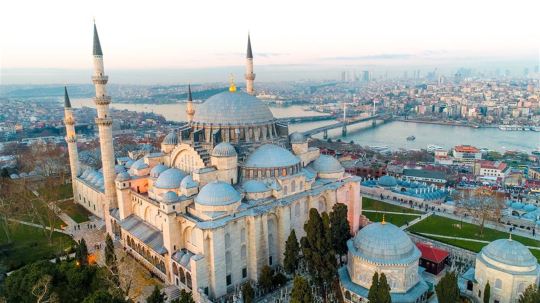
Civilization in Istanbul dates back to thousand years ago, and the city will provide you the old cultural soul you are looking for. Four corners of Istanbul is covered with historical places, cultural sites and museums. It is the central place for the synthesis of Anatolian and European culture: if we look back at the history, we will find many historical places in Istanbul that still exist up to date. Let’s take a retrospective gaze upon the most important and popular touristic places in Istanbul, along with the most overlooked ones.
Maiden Tower
Kizkulesi was founded on a rocky outcropping at the mouth of the Bosphorus in the 5th century BC by the Athenian general Alcibiades to keep an eye on the waterway. A chain was dragged from the land to the tower, converting it into a checkpoint and customs area for passing ships. Emperor Alexius Comnenos constructed a powerful defense tower in the 12th century AD called Arcla, which means "Small Tower," after many restorations in wood and stone. Following the Ottoman conquest of Constantinople, the tower was used as a lighthouse and control tower. The final restoration was completed in 1998, and the restaurant opened in 1999 after a 3 million dollar investment.
Kizkulesi is now a well-known and elegant restaurant and cafeteria-bar. It provides panoramic views of the Bosphorus and the old city, especially at night. At some times, shuttle boats run from the European side in Istanbul's Kabatas neighborhood and the Asian side's Salacak neighborhood to the tower. It's also a popular spot in Istanbul. On Mondays, the tower is closed.
Beylerbeyi Palace
Beylerbeyi is a palace overlooking the Bosphorus that was built between 1863 and 1965. Beylerbeyi is a rare location where history and historical characters blend with the present. It is a magnificent 19th-century monument that impresses with its set gardens and fascinates with its mansions.
Since the Byzantine Era, Beylerbeyi Palace and its surroundings have housed various structures. Sultan Abdülaziz had the house demolished and reconstructed after a fire in order to improve it. Between 1863 and 1965, the palace, along with its additional buildings covering a total area of 3000 square meters, took on its current look.
The main structure of the Mabeyn and Harem sections, as well as its additional structures serving various purposes, are open to tourists today: the sea pavilions, the historical tunnel linking Üsküdar and Beylerbeyi, Yellow Pavilion, Marble Pavilion, and the Barn Stables are all worth seeing. When you visit Istanbul, it is impossible to end your trip without seeing Beylerbeyi Palace.
Tiled Kiosk
Mehmet the Conquer designed the kiosk in 1472, and it is one of the earliest examples of Ottoman civilian architecture.
From 1875 to 1891, it served as the Imperial Museum. It was opened in 1953 as the Fatih Museum, which featured Turkish and Islamic art. Because of its location, it was given to the Istanbul Museum in 1981. The building has a single floor in the front and two floors in the back. During your Istanbul trip, pay a visit to this overlooked architecture. At the entrance, there is a marble arcade with 14 columns. Mosaic tiles are used to decorate the entrance. The museum and its storeroom include 2000 works in Kiosk.
Galata Tower
The Galata Tower, or Galata Kulesi in Turkish, is one of Istanbul's tallest and oldest structures. It is in Beyoglu district. The 63-meter-high (206-foot-tall) tower offers a panoramic view of the old town. It was constructed by the Genoese colony in the 14th century as part of the defense wall that surrounded their district at Galata, which was directly opposite ancient Constantinopolis. The tower was known as "Christea Turris," or "Christ Tower." The Genoese engaged in trade with the Byzantines, and the tower was used to keep an eye on the Golden Horn Harbor. It was used to detect fires in Constantinople after Mehmet II conquered the city.
Galata Tower was rebuilt after the Republic and reopened to the public in 1967. On top of the clock, there is a cafeteria, as well as a nightclub that was demolished after the last renovation in 2013. A couple of elevators will carry you up, but you'll need to ascend three more floors by stairs to reach the panoramic terrace, which is 52 meters above ground level. Within the tower, across from the ticket office on the entrance floor, is a small souvenir shop. You can also eat grilled fish in Istanbul next to Galata Tower!
0 notes